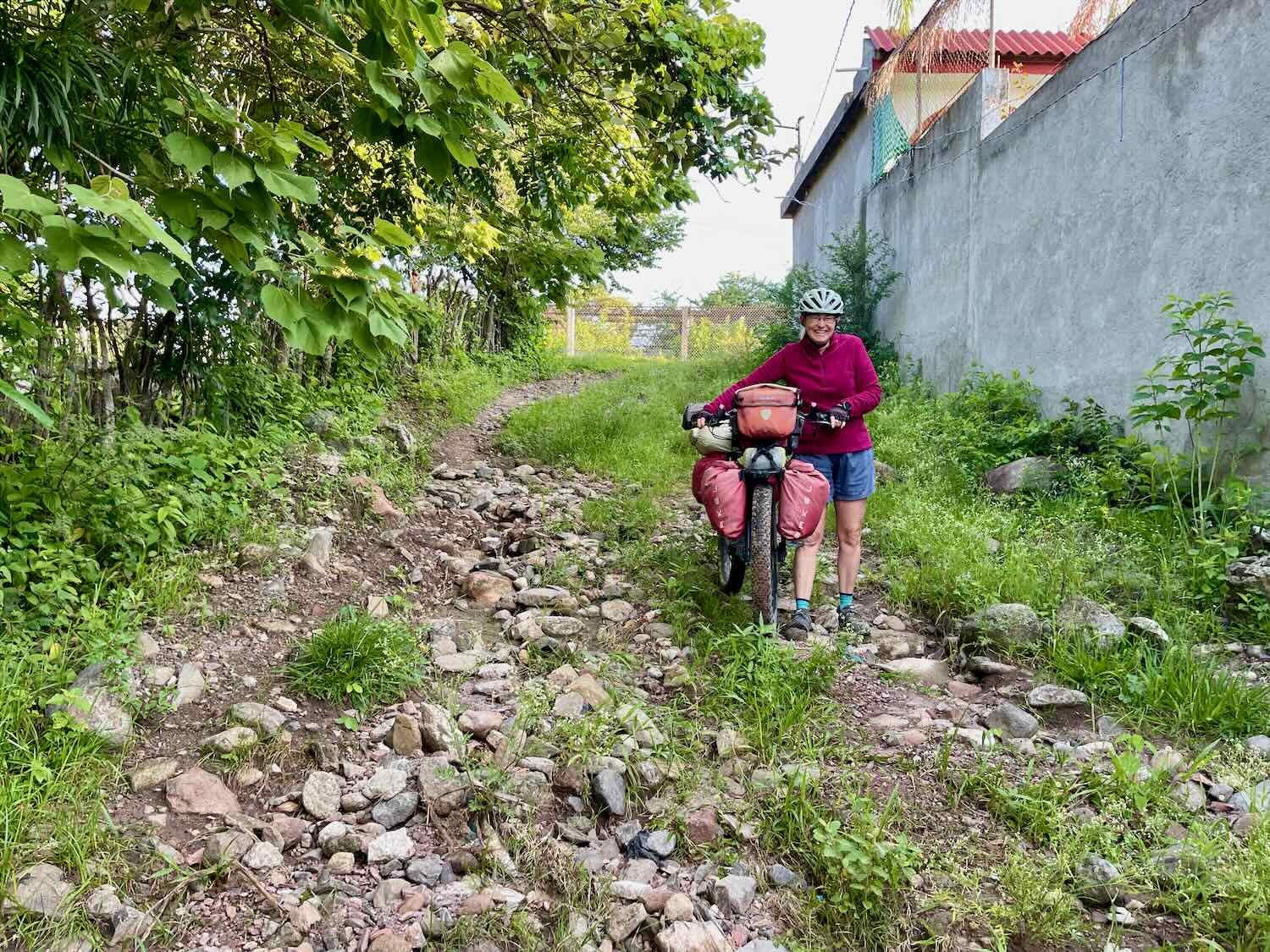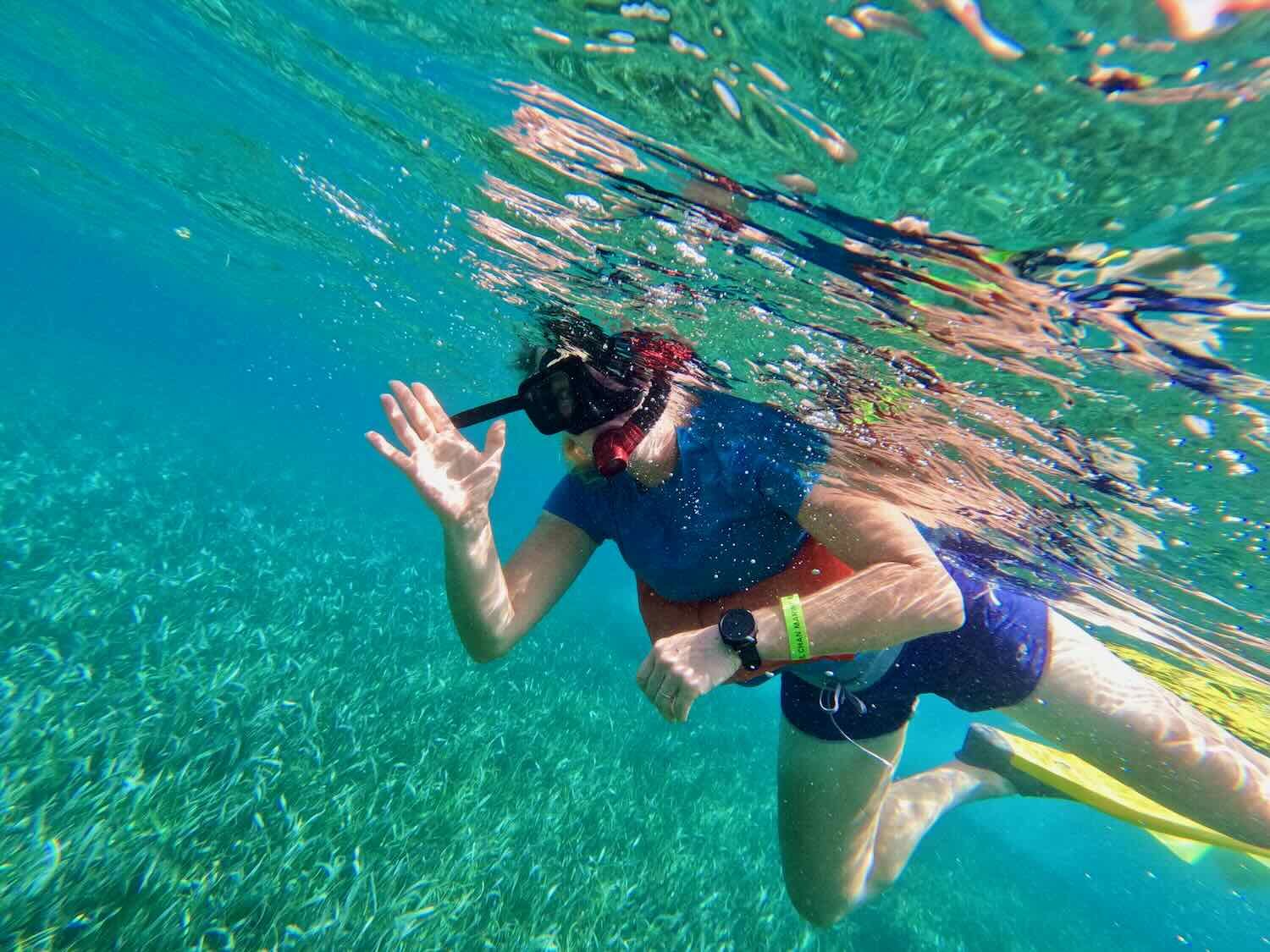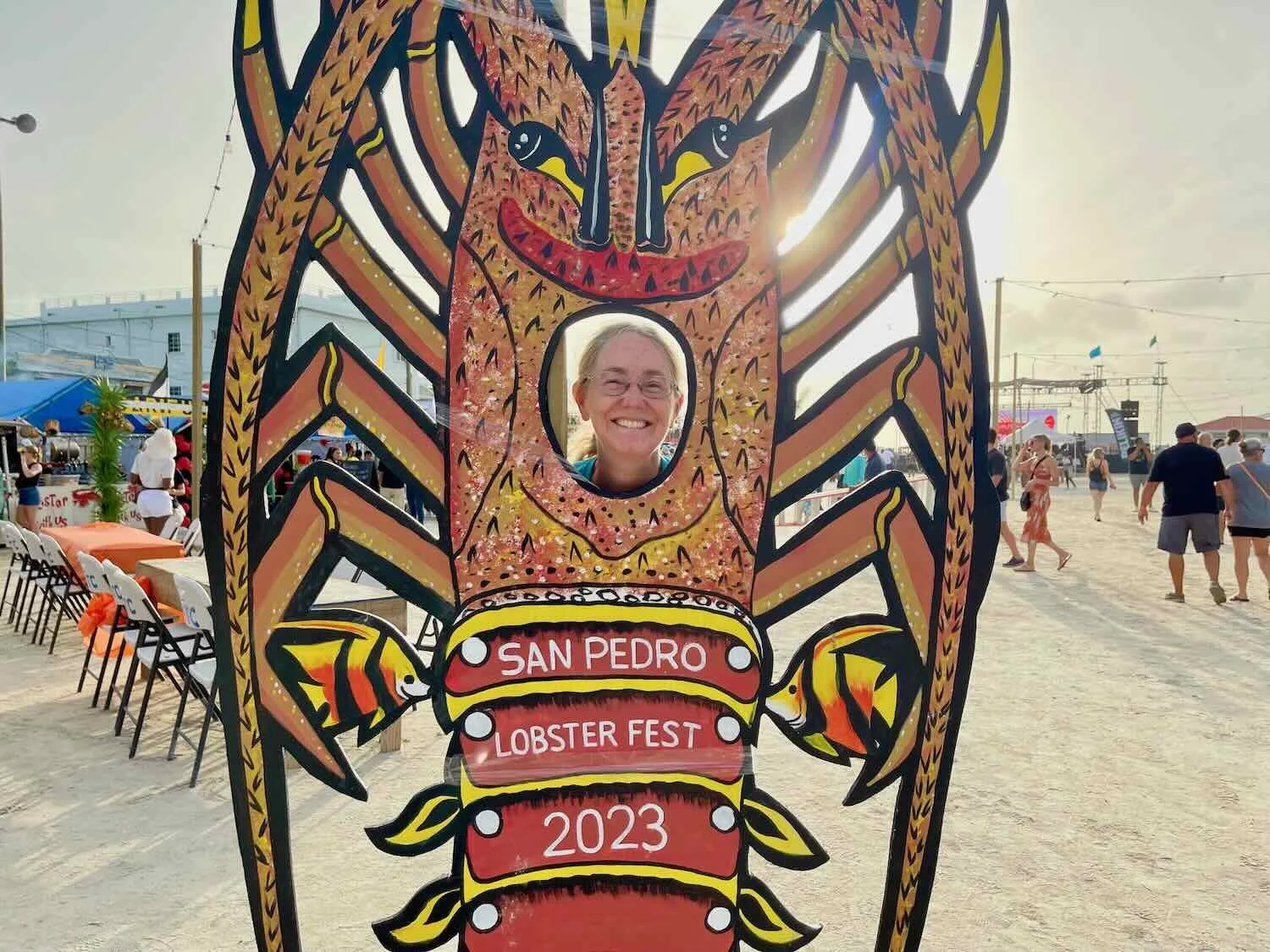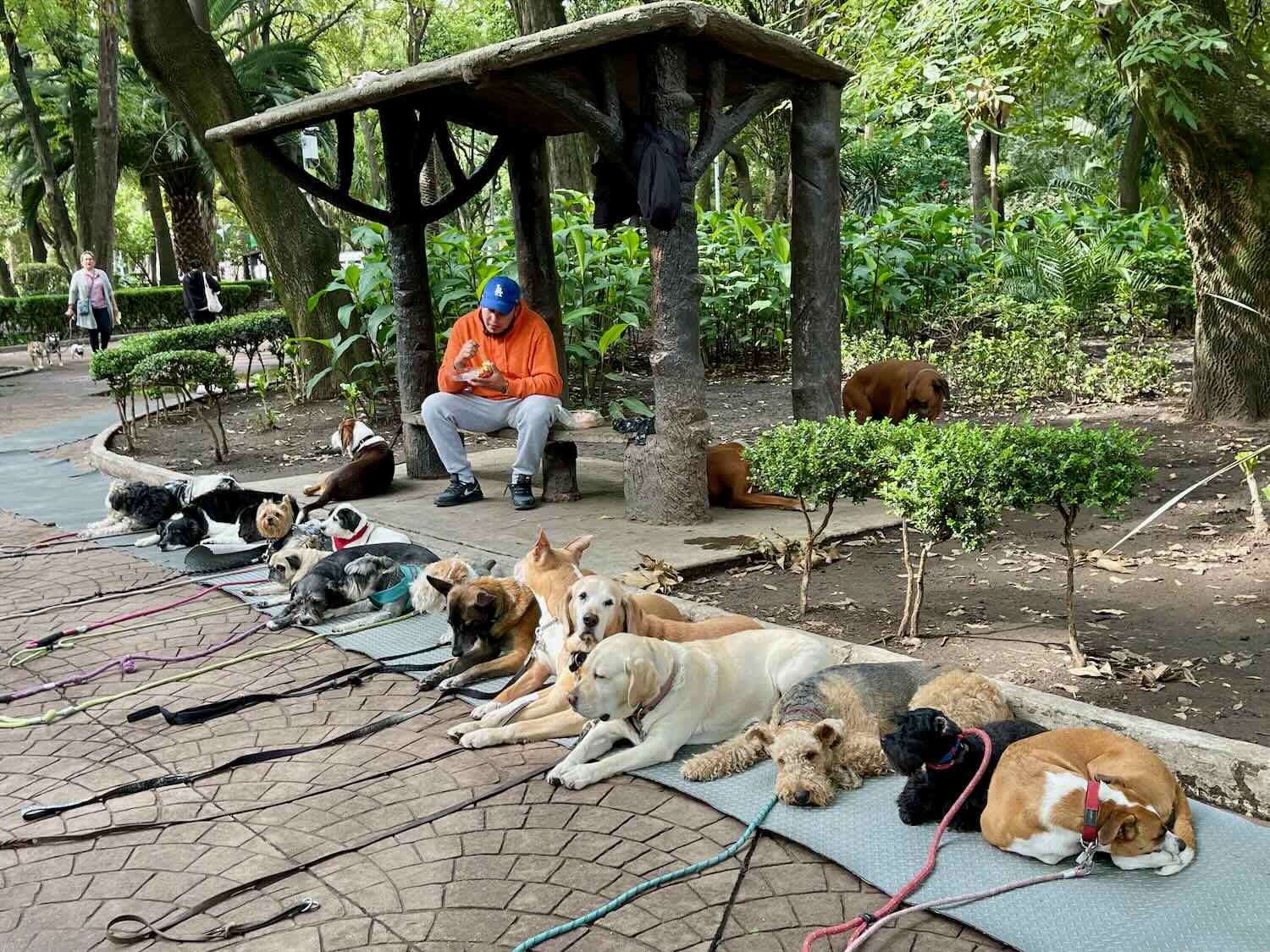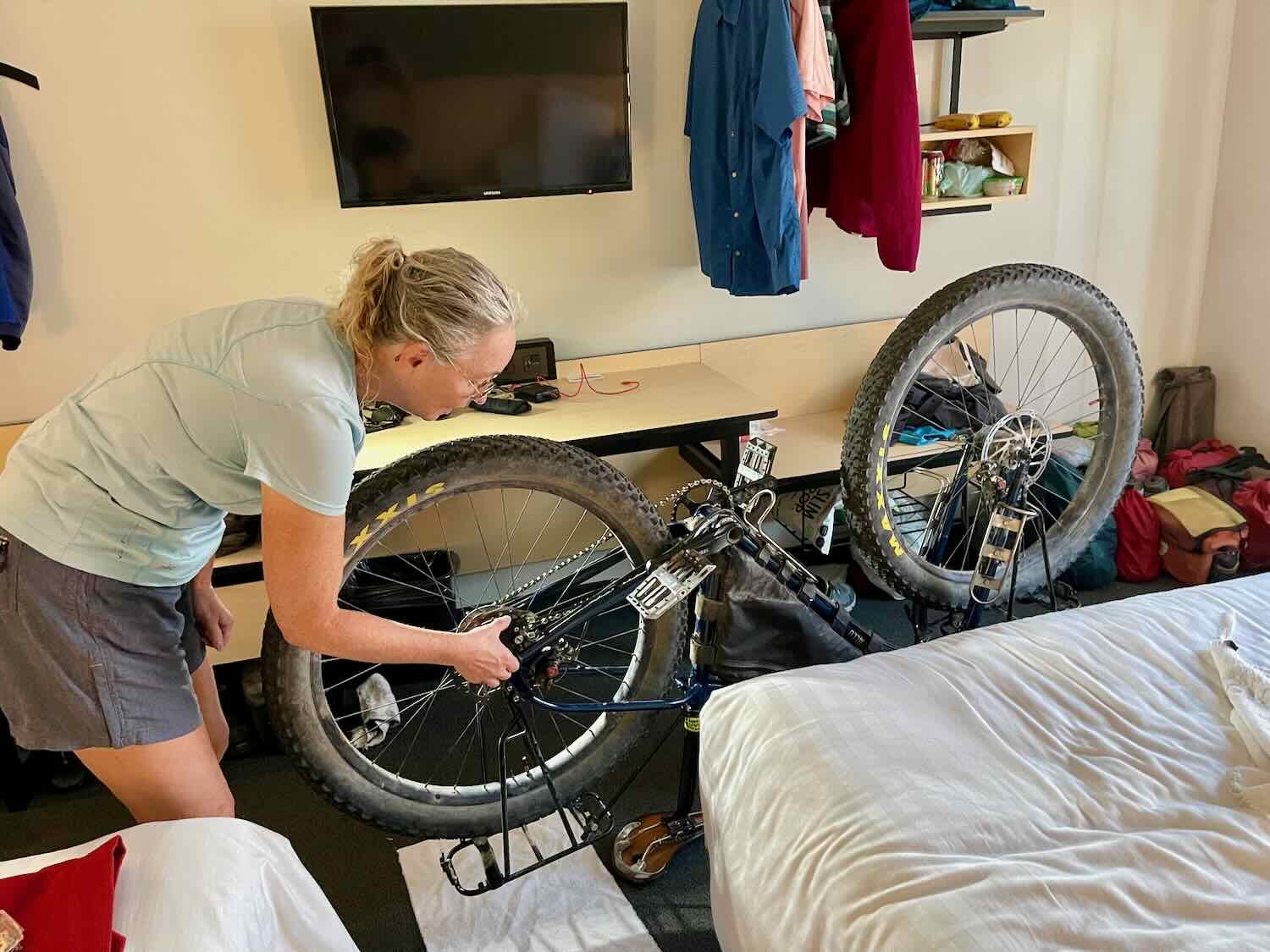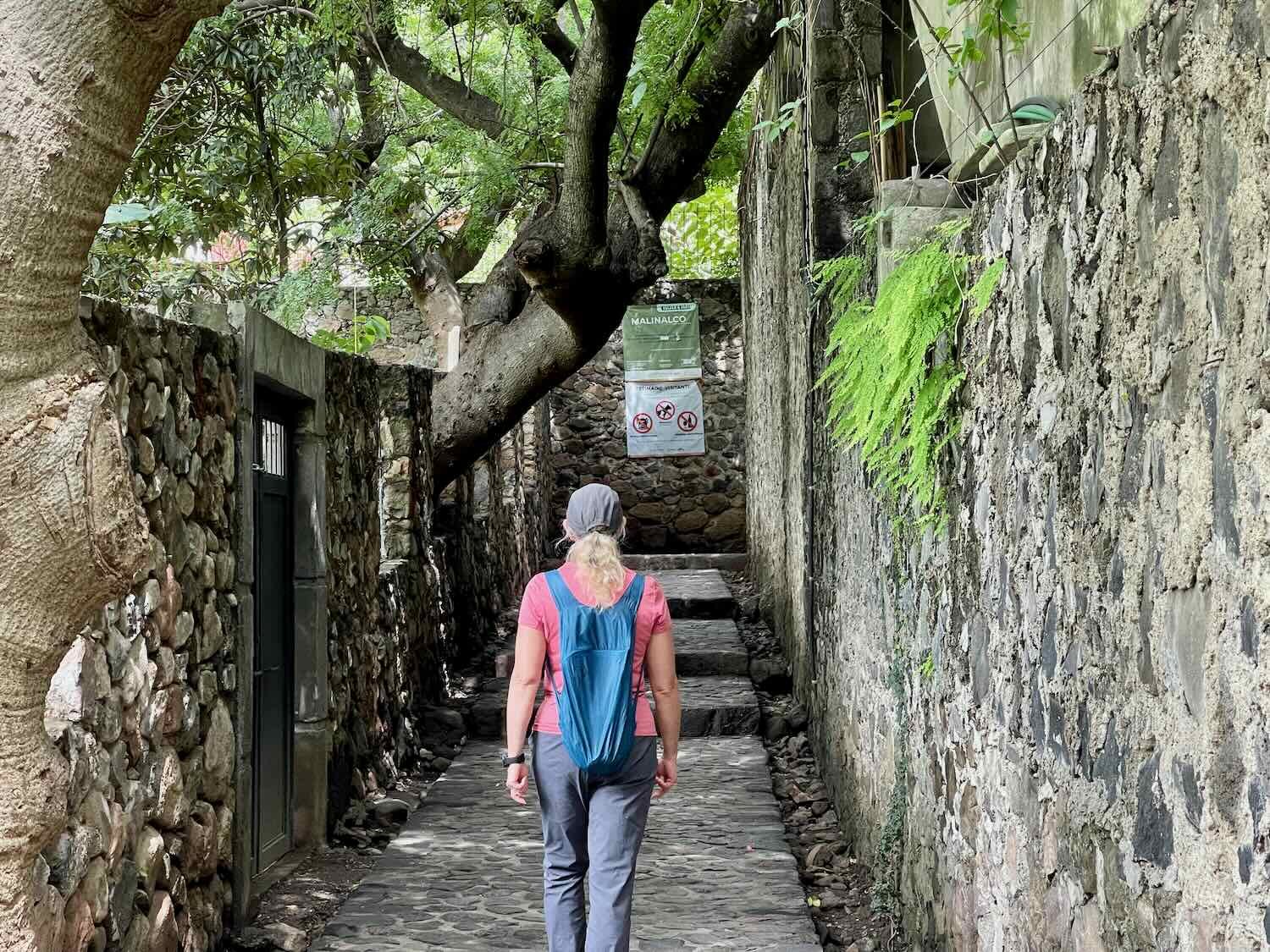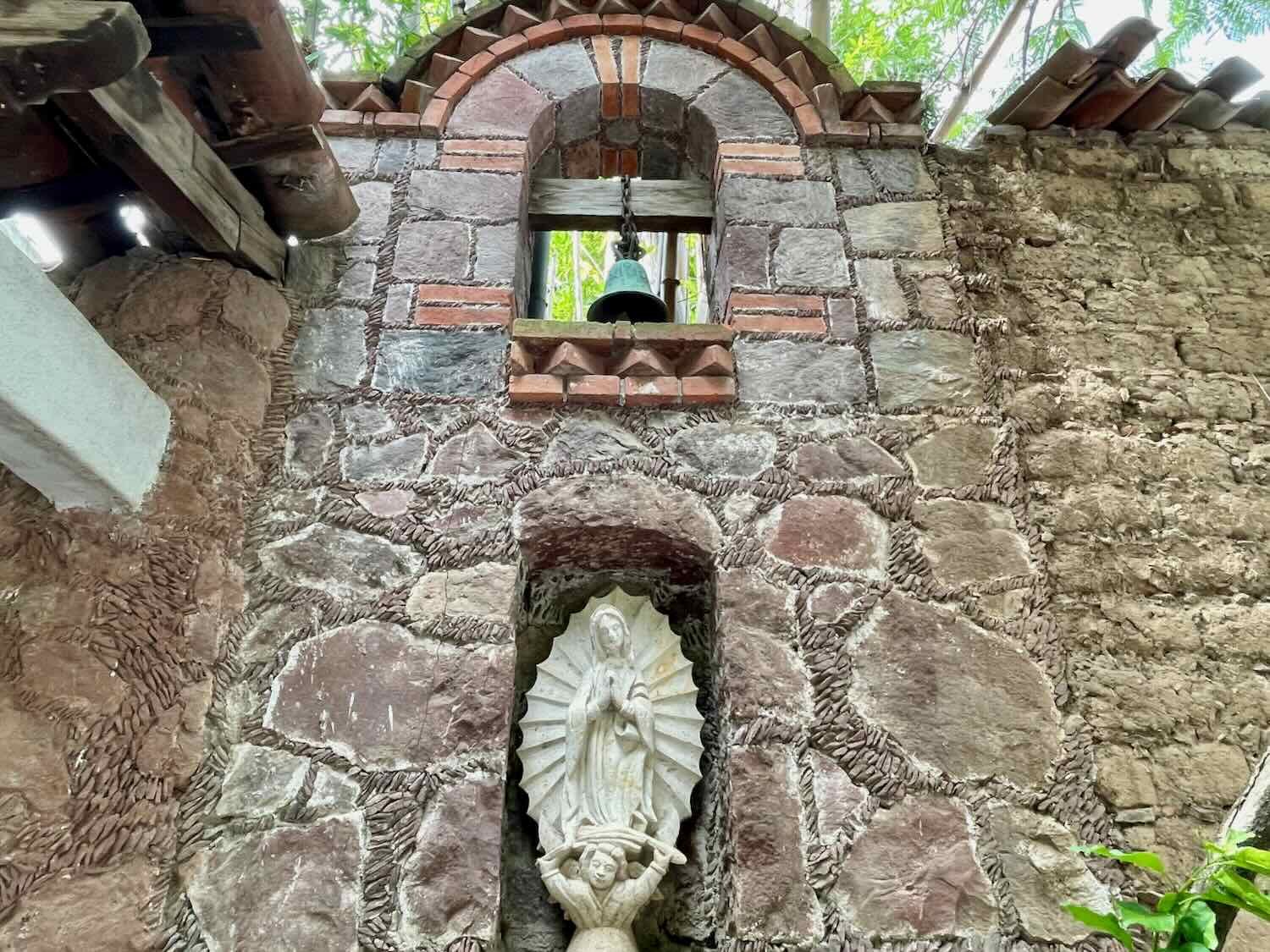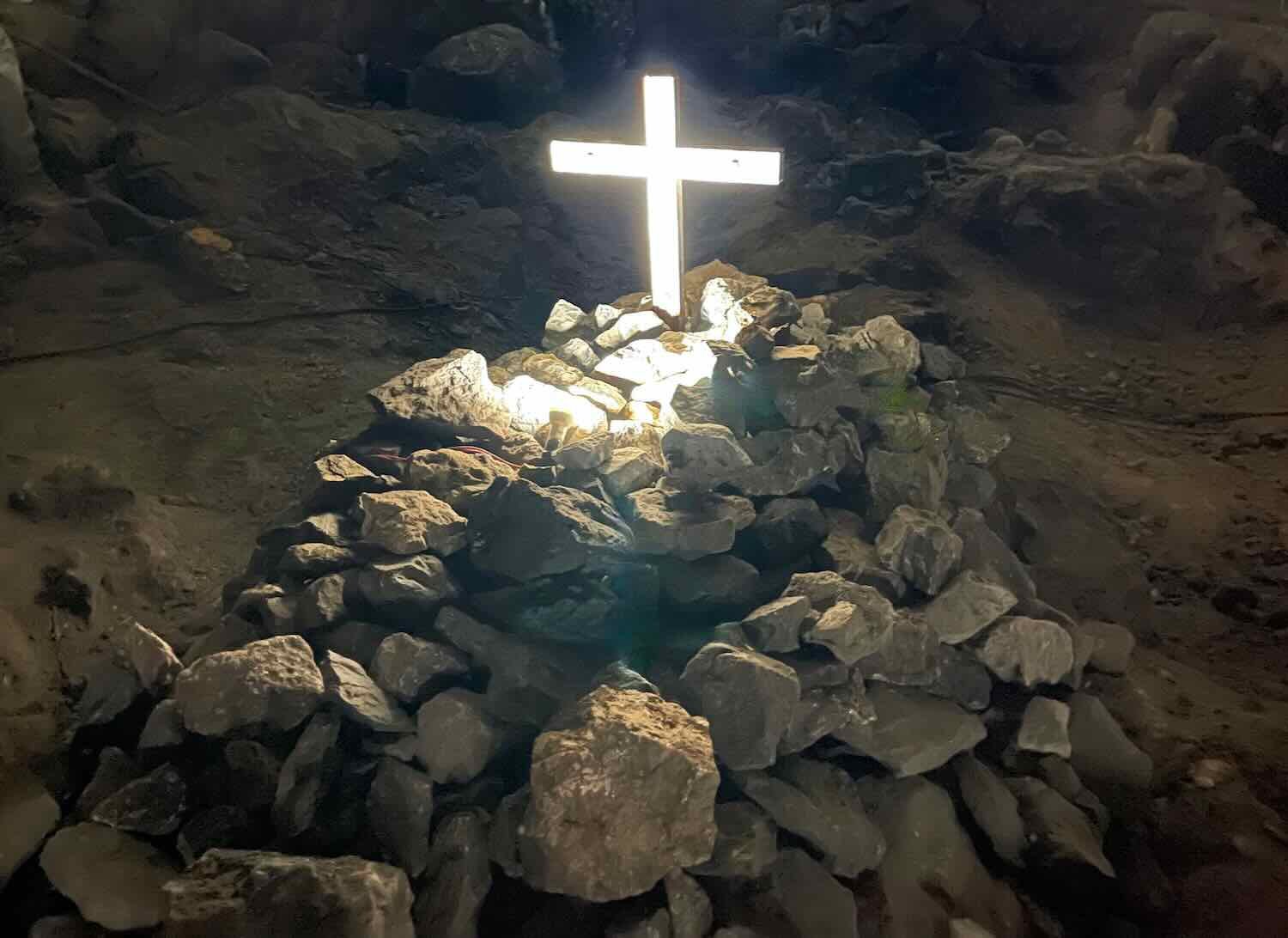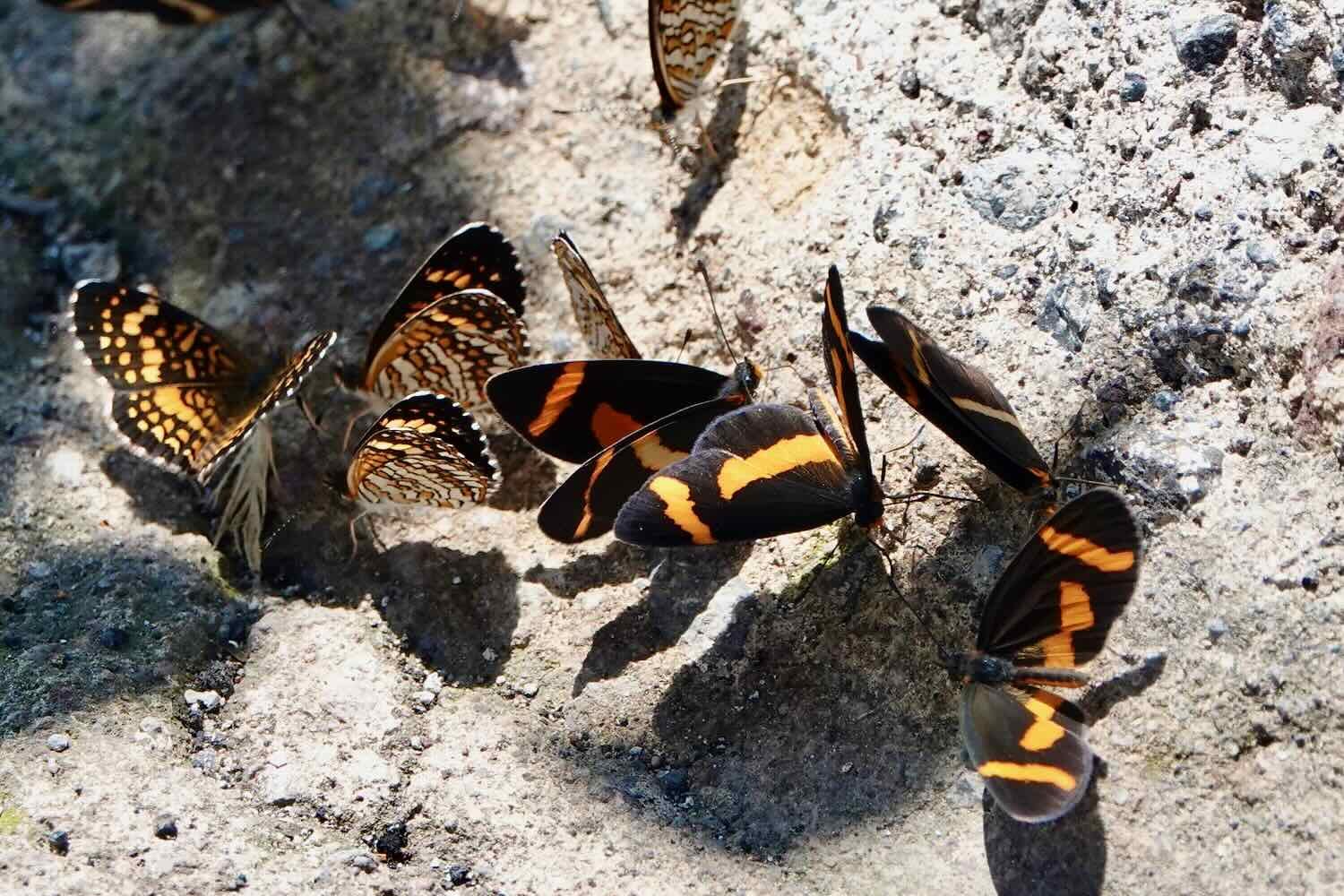TransMexico Norte Part 5: Cycling from Toluca to Izúcar de Matamoros, Mexico
20-28 August 2023
July-Aug - Rainy season layover in Mexico City, Yucatan and Belize
20 Aug - Toluca to Malinalco (37.1 mi, 59.7 km)
21 Aug - Rest day in Malinalco
22 Aug - Malinalco to Grutas de Cacahuampila NP (31.6 mi, 50.9 km)
23 Aug - Grutas de Cacahuampila NP to Tehuixtla (29.8 mi, 48.0 km)
24 Aug - Layover in Tehuixtla
25 Aug - Tehuixtla to Chinameca (31.7 mi, 51.0 km)
26 Aug - Chinameca to Axochiapan (25.7 mi, 41.4 km)
27 Aug - Axochiapan to Izúcar de Matamoros (23.5 mi, 37.8 km)
28 Aug - Layover in Izúcar de Matamoros
Arrival of the Rainy Season
We had been incredibly lucky. The rainy season in Mexico usually starts by the end of May. But in 2023 the rains were late, and we enjoyed dry, sunny (albeit hot) cycling weather throughout most of the month of June.
In the last week of June the rains finally came. As if someone had flipped a switch, the sun disappeared behind clouds and it started raining every day. Typically the morning hours were still reasonably dry. But by early afternoon powerful thunderstorms would roll in, dumping buckets of rain in intervals that would last throughout the night. The storms soaked everything, and sent medium-sized streams rushing down the margins of roads. Once the rain started, cycling on dirt was unthinkable.
This change in the weather coincided with the imminent expiration of our 180-day Mexican tourist cards. To legally finish our bike tour across Mexico we would soon have to leave the country, before returning and (hopefully) getting permission to stay another 180 days. The convergence of the rainy season with our need to leave Mexico inspired us to think about turning this procedural hurdle into a chance for some off-bike adventures.
A Place of Devotion in Mexico City
Our first stop was the bustling city of Toluca, the capital of the State of Mexico, which is just a short detour from the TransMexico North bikepacking route. It was the ideal place to stash our bikes for an extended period. While we probably could have left our bikes with a Warmshowers host, we didn’t want to impose on anyone for such a long break. Instead, we easily rented a closet-sized storage unit where our bikes could safely rest for a couple of months. The contract for the storage unit was a little over the top, with about 15 pages (front and back) of the smallest print we have ever seen - in Spanish, of course. Each page had to be signed and stamped with a finger print. The folks running the place were easy to deal with, and explained each page. They appeared very honest, so we put a lot of stock in that. Prior to saying “hasta luego” to our bikes, we gave them a nice bath to wash away the accumulated dust and mud.
Giving our bikes some TLC. We washed off the accumulated dust and dirt before storing our bikes for the rainy season. Toluca, State of Mexico, Mexico. Copyright © 2019-2023 Pedals and Puffins.
Our bikes, ready for their extended break in a Mexican storage unit. Toluca, State of Mexico, Mexico. Copyright © 2019-2023 Pedals and Puffins.
From Toluca we made our way to Mexico City. By chance, our hotel in the city was walking distance from one of the most famous religious shrines in the world, the Basilica of Our Lady of Guadalupe. Legend says that in the 1500s, at this site, the Virgin Mary appeared to a native man and told him to build a church on the hill. To convince the local bishop to obey the command, a miraculous image of the Virgin Mary was imprinted on the inside of the indigenous man’s cloak. That image is now ubiquitous throughout Mexico, and the Lady of Guadalupe is recognized as the patron and protector of the faithful throughout the Americas. Some estimates say that as many as 20 million pilgrims visit the basilica each year, placing it second only to St. Peter’s Basilica in Rome among Catholic pilgrimage sites. The big, old church exuded a quiet majesty, even in the overcast twilight that hung over our visit.
The 17th century Old Basilica of Our Lady of Guadalupe towers over a huge plaza, where millions of faithful Catholics gather for a pilgrimage each December. This historic structure is no longer used because it is sinking into the soft, Mexico City earth (note how the facade tilts to the left). A newer church on the site now houses the original, miraculous image of the Virgin Mary, and is used for modern church services. Copyright © 2019-2023 Pedals and Puffins.
We had decided to take an inexpensive, domestic flight from Mexico City to Chetumal, a small city near the border with Belize. From Chetumal, we took a water taxi to San Pedro, Belize, on the island of Ambergris Caye. Ominously, when we passed though Mexican immigration before boarding the water taxi, the border agent made a point of telling us that if we returned from Belize to Mexico via the water taxi, he would only give us a seven day tourist card upon re-entry! He seemed to have a pretty negative attitude, so we were glad that we did not plan to return to Mexico via that border crossing.
Exploring Belize
Our week on Ambergris Caye included a snorkeling trip out to the famous Belize barrier reef. One stop on the tour was a spot with the sinister name of “Shark Alley,” where schools of nurse sharks gather whenever they hear a boat approaching. Fishermen used to clean their catches there, and the sharks learned to associate boats with an easy snack. These days tour boats toss a bit of chum into the water with the tourists to keep the sharks interested. At first we weren’t sure it was such a good idea to get in the water. But the sharks were very gentle and not interested in messing with the swimmers. It was fascinating to see them at such close range, in their own element.
We also were fortunate that the island’s annual Lobster Fest was underway during our visit. Apparently folks travel from all over Belize to enjoy 10 days of lobster-themed fun. We sampled lobster burritos and lobster pizza, while soaking up the festive mood. There also was plenty of time for relaxing, walking on the beach, and spotting some of the tropical island birds.
From the Caye we headed inland to San Ignacio, in Belize’s Cayo District. That gave us the chance to visit some of the country’s fabled Mayan ruins, where we were free to clamber about on the ancient stones. More wildlife watching among the crumbling temples whetted our appetite for the exotic plants and animals we would see further down the road, once we cycled into Central America. We even took a canoe trip down a river inside a cave, which was just one of many river trips that are possible in the Cayo District, where ecotourism thrives.
It was a nice change of pace to transition from Spanish to English, and from pesos to dollars. Belize has three official languages: Spanish, Creole and English, with English being the most common. Most natives speak all three. They also use both American dollars and Belize dollars. When receiving change for a purchase, it’s common to get a combination of US dollars and Belize dollars at the same time. That can be is a little confusing, since the exchange rate from Belize dollars to USD is 2:1.
The markets in Belize felt a little bit more sparse than many we had visited in Mexico, probably because most products are imported into this very small country. Food was more expensive, too. But some local items, like coconuts, were available in abundance. We did a double-take when we first saw signs advertising the sale of “drugs and poisons.” It turns out that Belize has an official list of “poisons” that can be sold only by licensed chemists, ranging from toxins like arsenic, to addictive painkillers, and even extracts of wild plants like lobelia. Somehow having poisons and medications sold by the same person seemed less than ideal. But in practice it probably works out fine.
A Difficult Return to Mexico
After a couple of relaxing weeks in Belize it was time to head back to Mexico. We took a bus to the border town of Corozal, Belize, then hired a taxi to take us across the vehicles-only border crossing, and back to Chetumal, Mexico. The departure procedures from Belize were swift and efficient. But based on the unpleasant send-off we had gotten from the border agent when we left Mexico, we were somewhat nervous as we approached the office for Mexican immigration. It turned out that our fears were justified.
The rules for tourist cards in Mexico are changing. Historically, you could get a 180-day tourist card, then briefly leave the country, and easily get another 180 days upon returning to Mexico. In fact, you could keep renewing as long as you left the country in between. Unfortunately, that is no longer the case. Some border agents only issue tourist cards for short periods of time (e.g., 1-2 weeks), even for your first visit. If you try to get a second tourist card in the same year, it can be especially difficult (but not impossible) to get one for multiple months. It is left up to the discretion of the immigration official to decide how long you can stay in the country.
These days, if you return after recently having been in Mexico on a tourist card, they prefer that you apply for a temporary resident’s visa - which is a long, expensive process that has to be completed at a Mexican Embassy outside of Mexico. We did not have the time, or want to spend the money, to go down that path since our remaining time in Mexico was going to be relatively short (the temporary resident’s visa is good for multiple years). Someone offered to help us acquire the desired 180-day tourist cards if we paid an extra 6000 peso “fee” (about US$350). He was a reliable source, who had connections with the border agents, and who had helped others. But not only was that a lot of money, bribes are something we really don’t want to encourage. Bribes are like a disease that only gets worse, leading to more corruption in the system the more they are used. We decided to take our chances and hope for the best through normal channels.
When we got to the front of the line, a border agent asked how long we needed to be in Mexico. When we told her we would like a 180-day tourist permit, she scoffed and said, “Two weeks, no more.” Period. When we protested, she told us that if we didn’t like it, she would give us only seven days. Those were our choices. We tried explaining that we were cycling across the country, that our bikes were still in Mexico, and that we just needed the time to make it from Mexico City to the Guatemalan border by bicycle. We did not have a car, and the trip takes extra time by bicycle. She was unmoved and simply repeated what she said before.
After getting out of line and discussing the situation we decided to get back in line and try again. This time the same border official said she would give us 30 days or two weeks, it was up to us. She said that the rules required her to give us no more than 30 days, and her hands were tied (which was not true). We begged and pleaded, and asked if there was any way to get more time. She really did not care and stuck to her story.
Our situation was getting difficult. We had run out of options and we were starting to think that we might not be able to finish our trip in Mexico. At that moment, another agent arrived - a younger guy who seemed to have less of a chip on his shoulder (perhaps because he had just had a good nights sleep, had just started his shift, and had not been up all night like the first agent we had talked to). After a brief conversation with us, he said he could give us 60 days. That was a big improvement from the two weeks we had been offered at first, but still not enough time.
We went to the back of the line and had a brief conversation with our taxi driver, who was clearly feeling bad about the way things were going. But he also was getting a little impatient, since we had been at this for nearly two hours and still had not cleared the border. The line was starting to get shorter, so we figured we would give it a cooling off period and try a fourth time. When we finally got back to the front of the line, we gave one more impassioned pitch for needing at least 150 days. The lady border agent was clearly tired of dealing with us and was getting irritated. She told us to let her think about the situation. But then she got word that her shift was finished and quickly left to go home without giving us an answer.
We went back to the guy who offered us 60 days. He studied the situation for 15-20 minutes as we pleaded our case, and reluctantly said he could give us 90 days. Not being ones to give up easily, we decided to then talk to the supervisor on duty. He was aghast that we were even offered 90 days. At this point we felt like we were treading on dangerous ground, and could have the 90 day offer rescinded if we weren’t careful. We went back to the agent who offered 90 days, got our passports stamped, and entered Mexico to the great relief of everyone involved. The 90 days was half of what we had hoped for, and planned on, but not the total disaster of 1-2 weeks that we were initially offered.
Getting Our Groove Back in Mexico City
But life goes on. And after thinking about it, we realized that we just might be able to make this work. Looking closely at our plans, we couldn’t be certain, but we thought we might be able to make it all the way it to Guatemala in 90 days (or at least most of the way there). If we didn’t make it to the border in time, we could load our bikes onto a bus. But our goal was to make it all the way on our bikes.
We simply had to adjust our expectations. For example, we would have to be much more careful about taking any impromptu breaks in interesting places. There wouldn’t be any extra time for that. We also would have to stay on pavement more than we typically do, because riding on dirt tends to slow things down considerably. And our plans to sit out the rest of the rainy season (which would last for another 1.5 months) in Mexico City were now impossible. With a 90-day deadline to leave the country, we would undoubtedly end up cycling through some rain. But these were manageable adjustments. Once we accepted our new reality, we felt a lot better.
Even with the much tighter timeline, we decided that we could afford to spend some extra time in Mexico City. A big factor was that we already had made a 10-day, non-refundable lodging reservation in the city. Plus, the weather was still very unsettled, with heavy rain most days. And we really love the lifestyle in Mexico City.
We filled the next 10 days with long walks through the Roma, Condesa and Polanco districts, the Chapultepec Park and the historic Centro. Mexico City’s shops were also perfect for replacing a couple of worn out clothing items. We even saw Mexico City’s famous dog walking services in action. In a photo below, the one person sitting on the bench is watching over 15-20 dogs. People hire professionals to take care of their dogs while they are at work during the day. The dogs get exercise, plus they are trained in obedience at the same time. We watched for five minutes, and all the of dogs in the picture seemed to be calmly resting without any desire to go chasing after other dogs or people.
Ciudad Mexico (abbreviated CDMX), was perfect for an extended break in one of the world’s most enjoyable, cosmopolitan cities. Mexico City, Mexico. Copyright © 2019-2023 Pedals and Puffins.
Then we returned to Toluca to retrieve our bikes from the storage unit and prep for getting back on the road. In our hotel room we made a few, final mechanical adjustments to our bikes. We also ordered new bottom brackets from the USA, but those required a specialized tool to for installation. Luckily, we found a bike shop that could help us. And in typical Mexican style, instead of telling us to come back in a few days, a couple of guys changed out our bottom brackets while we waited. That was wonderful. There even was time for one more trip to Toluca’s historic district, and a peaceful stroll through the city’s manicured botanic gardens.
Back On the Road
By the time we departed Toluca, we had spent nearly two months off of our bicycles. That was plenty of time for our bodies to go soft, losing most of the conditioning we had built up over the past year of bicycle travel. Consequently, we decided to ease our way back into bikepacking by keeping the first week of rides relatively short, with several recovery days built in. Shorter days would also allow us to end the rides earlier in the day, and help us avoid the heavy afternoon rains which were still frequent.
The first two hours of cycling flew by, as we crossed the pancake flat Toluca Plain. We stayed off the main highway, on secondary roads that cruised through a continuous series of small towns. There was a surprising amount of agriculture blanketing the landscape between towns - especially cornfields. Every so often we heard the BOOM of a cannon nearby, presumably to scare birds away from the crops.
Cycling past the cornfields that blanket the Toluca Plain (on the southern end of Mexico’s central high plains). Mountains of the Trans-Mexico Volcanic Belt loomed on the horizon. South of Toluca, State of Mexico, Mexico. Copyright © 2019-2023 Pedals and Puffins.
It seemed as though every town we rode through had a Sunday market in full swing. We must have made at least four or five detours around the throngs of Sunday shoppers and vendors in pop-up tents. With all of the agriculture in the area, the stalls were brimming with a wide variety of produce. Bargain clothing, household goods, and rows of street-food vendors rounded out the colorful and vibrant atmosphere.
A corner of the Sunday market in one of the small towns along our route. The vendors in pop-up tents would take over whole streets, causing us to make multiple detours throughout the day. Santiaguito Cuaxustenco, State of Mexico, Mexico. Copyright © 2019-2023 Pedals and Puffins.
Before long we turned onto a dirt road and began climbing back into the volcanic hills that cut from west to east across southern Mexico. The soil was rich and dark, without much gravel - so the water from all the recent rain hadn’t drained very well. There were lots of puddles, and PedalingGal ended up accidentally sinking one of her feet into a deep pool - soaking her foot with muddy, brown water up to her ankle. Yuck! Many of the slopes were quite steep. In the few towns that we passed through, the roads would briefly be paved with concrete on the steepest sections, so that they didn’t become a rutted mess during the rainy season.
In the volcanic hills that border Mexico City, remote villages pave their roads with scored concrete so that they don’t become a sloppy, muddy mess during the rainy season. San Pedro Zictepec, State of Mexico, Mexico. Copyright © 2019-2023 Pedals and Puffins.
The ancient volcanic cones surrounding us were all cloaked in rich shades of green. In many places the steep hills had been cleared of trees, which were replaced by a patchwork of small corn and squash fields clinging to the slopes. Elsewhere the hillsides were blanketed with the white, plastic domes of greenhouses.
Looking out over a rural, mountain valley. The steep, volcanic slopes were carved up into numerous small, farm plots mostly growing corn or squash. Santa Cruz Xochiaca, State of Mexico, Mexico. Copyright © 2019-2023 Pedals and Puffins.
Some of the hillsides were blanketed with the white, plastic domes of greenhouses. Santa Cruz Xochiaca, State of Mexico, Mexico. Copyright © 2019-2023 Pedals and Puffins.
As the day wore on, our lack of physical conditioning started to catch up with us. Although the cycling should not have been too difficult, there were still a lot of hills. PedalingGal, in particular, struggled up some of the climbs - especially towards the end of the day. For long stretches the forest would close in around us, giving us the feeling of being far out in a lush, humid, montane wilderness.
Hiking up one of the steeper hills through the lush, montane forest. Santa Cruz Xochiaca, State of Mexico, Mexico. Copyright © 2019-2023 Pedals and Puffins.
Hermit warblers are most at home in high-altitude coniferous forests. Many spend their winters in the upper reaches of Mexico’s central and southern mountain ranges. Santa Cruz Xochiaca, State of Mexico, Mexico. Copyright © 2019-2023 Pedals and Puffins.
A quiet street in a remote mountain village. Santa Cruz Xochiaca, State of Mexico, Mexico. Copyright © 2019-2023 Pedals and Puffins.
After cresting the final ridge of the day, we rolled into the mountain town of San Simón el Alto (pop. 3,100). Near the edge of town, traffic had been stopped by a police blockade. We wondered what was going on - perhaps there had been an accident? When we reached the front of the line, we saw a vehicle rolling slowly towards us - no faster than a person might walk - surrounded by a big crowd walking next to it.
We had come upon a funeral, and the police were blocking traffic in both directions for the funeral procession. Ever so slowly, the group gradually approached us. There was a band with multiple horns and drums playing a slow-tempo song. Many people in the gathering carried flower arrangements. Others were singing along with the band. There was no hurry. The rest of the world could wait while they made their way to the cemetery and paid their respects.
A funeral procession approached, blocking all passage on the main road through town. San Simón el Alto, State of Mexico, Mexico. Copyright © 2019-2023 Pedals and Puffins.
After about 25 minutes, the front of the group reached the spot where we were standing, and turned to slowly pass through the cemetery gate. Not long after that, the police allowed us to pass - even though there were still many mourners standing in the road. Fortunately for us, there was enough room for bikes to get through.
From there we had a fast, nearly 2,000 ft (600 m) drop out of the mountains to the Pueblo Mágico of Malinalco.
Made it to Malinalco, a magical town in a mountain valley. Malinalco, State of Mexico, Mexico. Copyright © 2019-2023 Pedals and Puffins.
The setting of the town at the base of some sheer, forested cliffs is absolutely stunning. The “Hill of the Idols” rises abruptly from the edge of town, creating a dramatic backdrop that can be seen from almost anywhere. It was on this hill that the Aztecs built a sanctuary for their military elite, known as the Eagle and the Jaguar Warriors. And even before the Aztecs conquered the local inhabitants in the 1400s, the area had a reputation for magic and sorcery. Gazing at the impressive scenery, it’s easy to grasp how this land would have exerted a mystical pull on the people who came here.
The “Hill of the Idols” rises abruptly at the edge of town, providing a dramatic backdrop that can be seen from almost anywhere. Malinalco, State of Mexico, Mexico. Copyright © 2019-2023 Pedals and Puffins.
To ease ourselves back into bicycle travel and allow our legs to build up strength, we took a day off in Malinalco. So the next morning we were keen to visit the archaeological site that included the Aztec temples of the Eagle and Jaguar Warriors. Along the way we passed through the historic, central plaza which was bustling with activity and lined with vendors’ stalls.
Colorful flags decorated a nearby road, seen here from the courtyard of the town’s central cathedral. Malinalco, State of Mexico, Mexico. Copyright © 2019-2023 Pedals and Puffins.
The walk to the archaeological zone took us down a picturesque, tree-shaded and stone-lined pathway.
But to our dismay, the park with the ruins was closed. We had arrived on a Monday - and many of Mexico’s cultural sites are closed Mondays. It was doubly disappointing because - with our 90-day tourist cards - we didn’t have time to stay in Malinalco another day so that we could visit the site. Perhaps we will have the chance to go back again someday.
With our primary activity now off the table, we took the time to walk around the town some more. There were a number of beautiful murals and colorful flower arches - a form of artistic expression that goes back to ancient, pre-Columbian times. We first started noticing the floral arches as we cycled into Toluca, and now they were showing up everywhere. It was quite common to see brilliantly-colored floral arches decorating the entrance to churches, chapels, towns, and gardens.
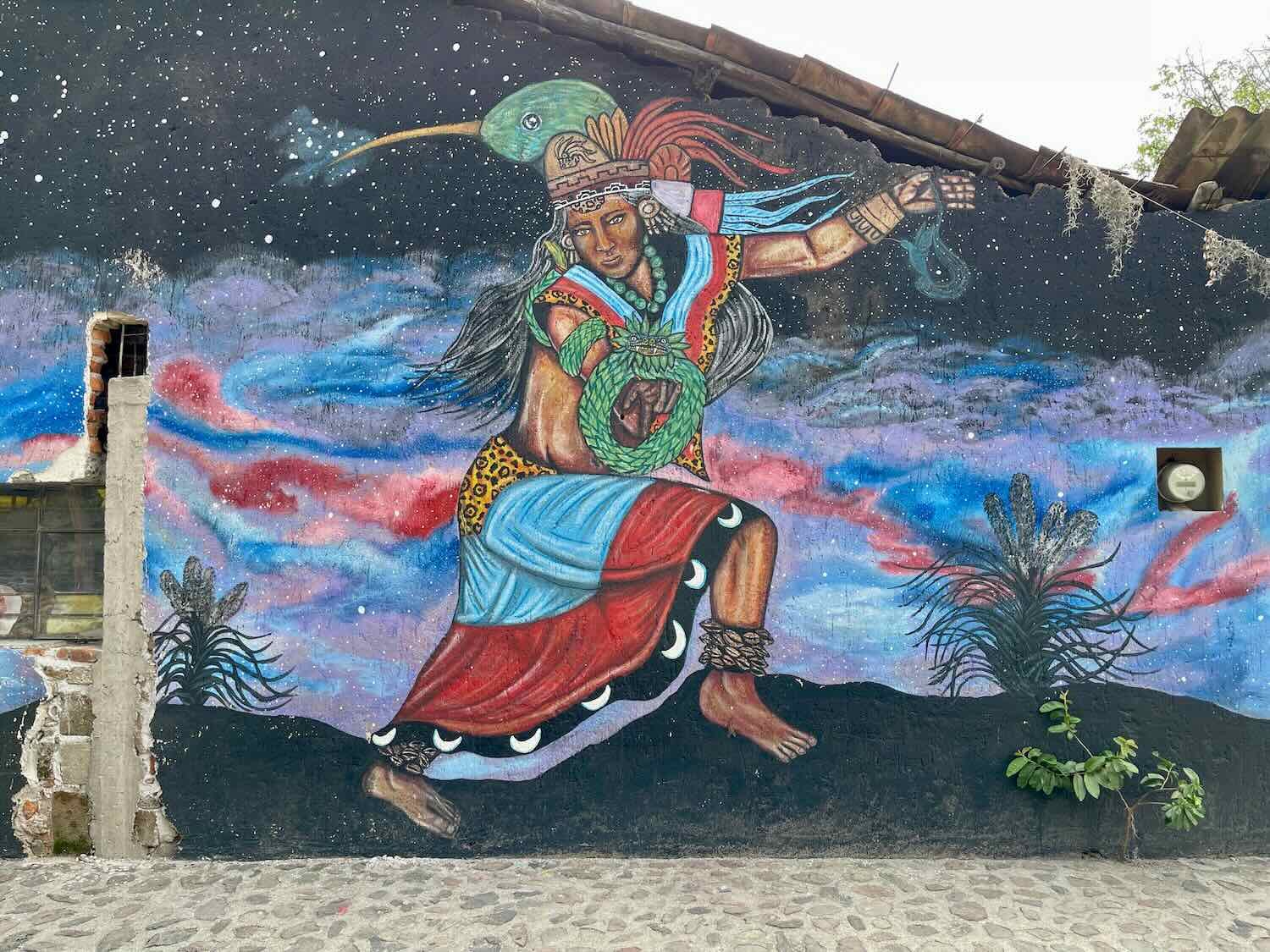
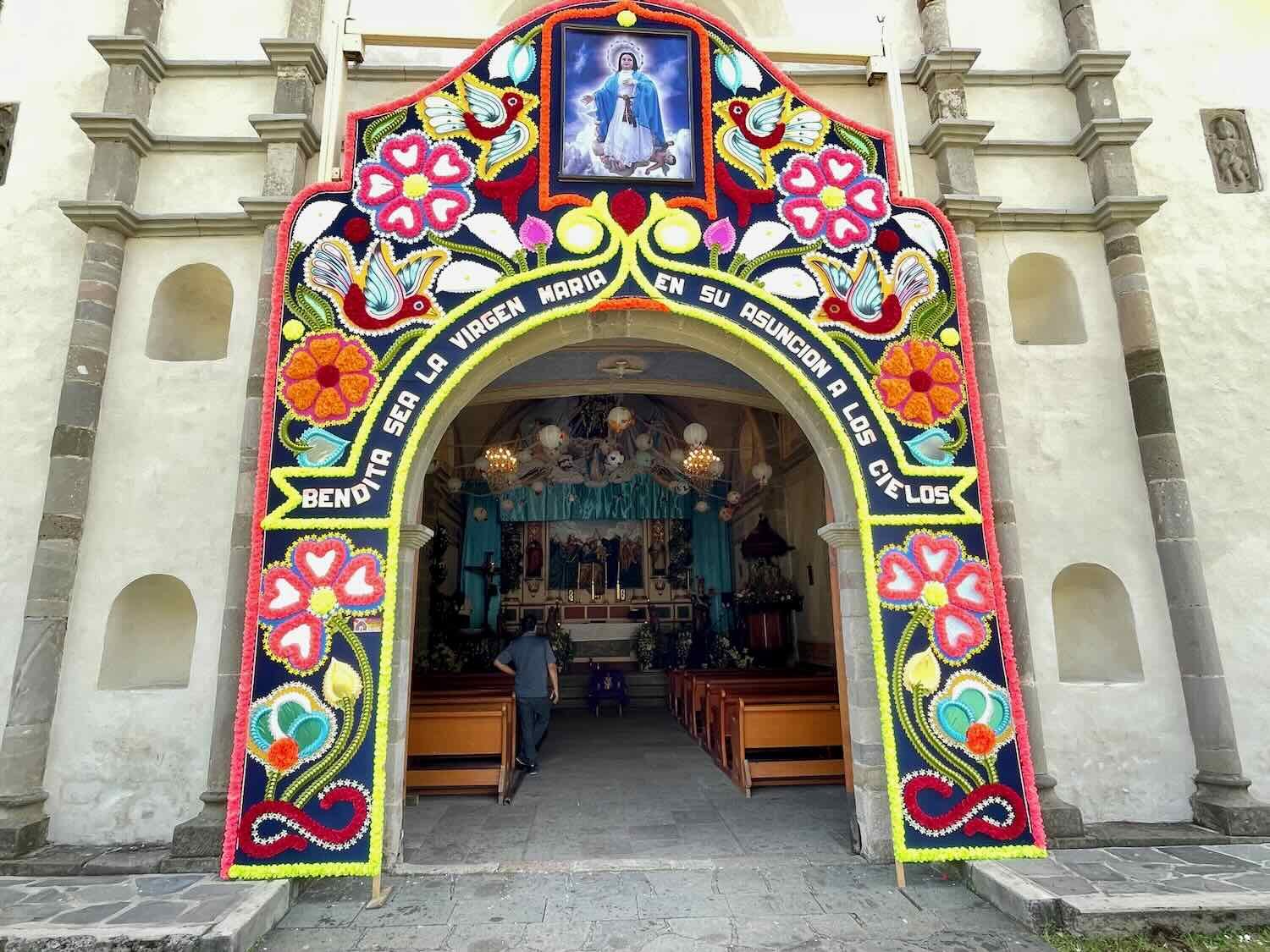
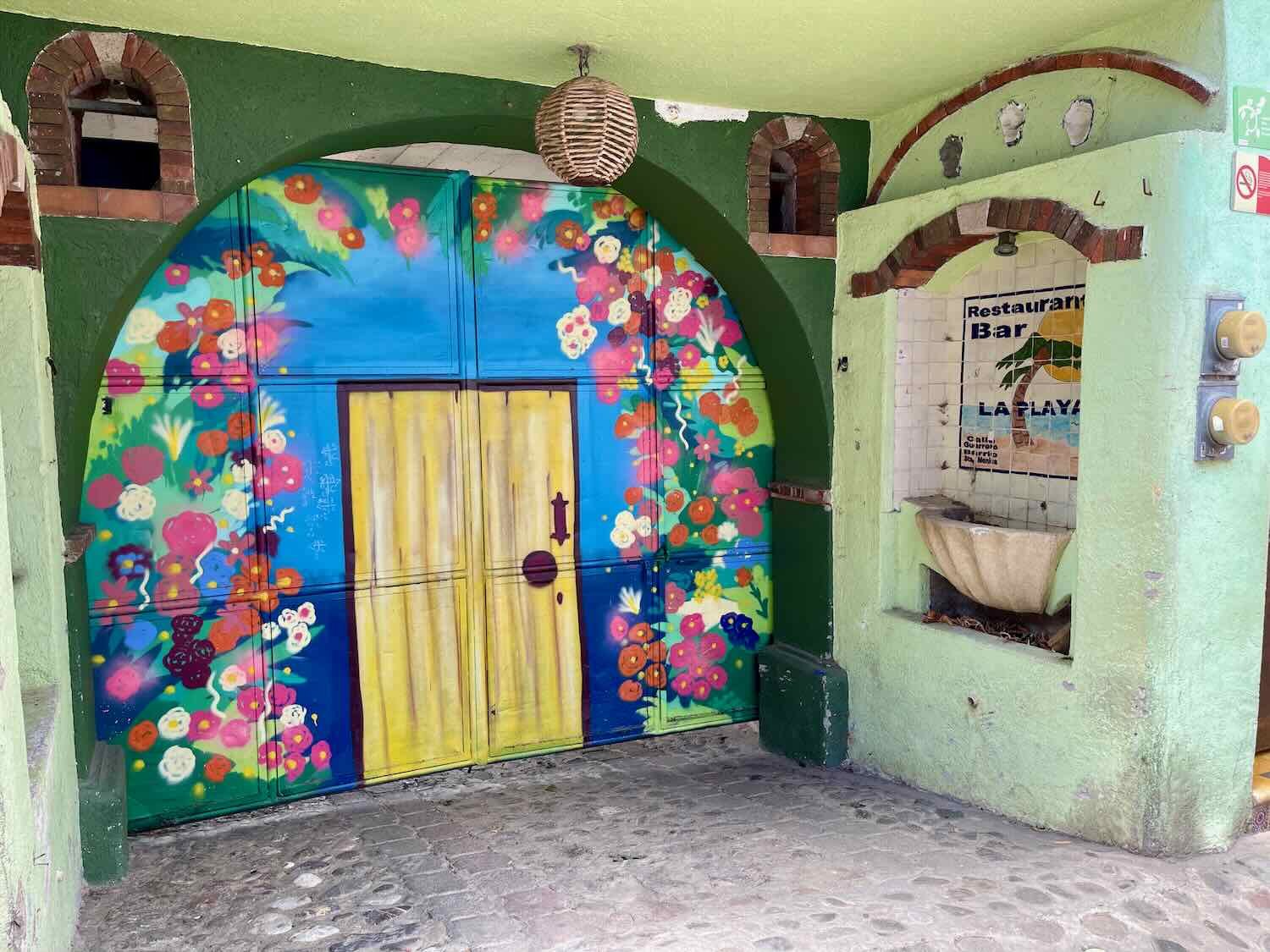
The Living Museum of Malinalco
As we exited the courtyard of a small chapel, we were stopped by a woman who asked if she could speak with us. Bidi Juárez had lived in the USA for a while, and she was eager to practice her English for a few minutes. We chatted with her for some time, learning a bit about her life and telling her about our travels. We asked if she had any ideas of what we could do in the town, since the archaeological site was closed. She suggested that we visit a museum that we hadn’t heard of before. It sounded like a great idea.
While the official name is the Living Museum (Museo Vivo), its nickname is “Los Bichos de Malinalco,” which roughly translates to “the Little Critters of Malinalco.” The price of admission included a guided tour (in Spanish), led by a very enthusiastic young woman. She took us through a series of exhibits about the native plants and animals of the Malinalco region. And at most of the stops we were given a chance to touch or hold a representative critter. Along the way we cuddled with a boa constrictor, released a recently-emerged monarch butterfly into an atrium, and handled everything from a tarantula, to a praying mantis, and a few other big bugs. We had fun, and enjoyed watching a couple of young boys show off their bravery by handling the critters, too.
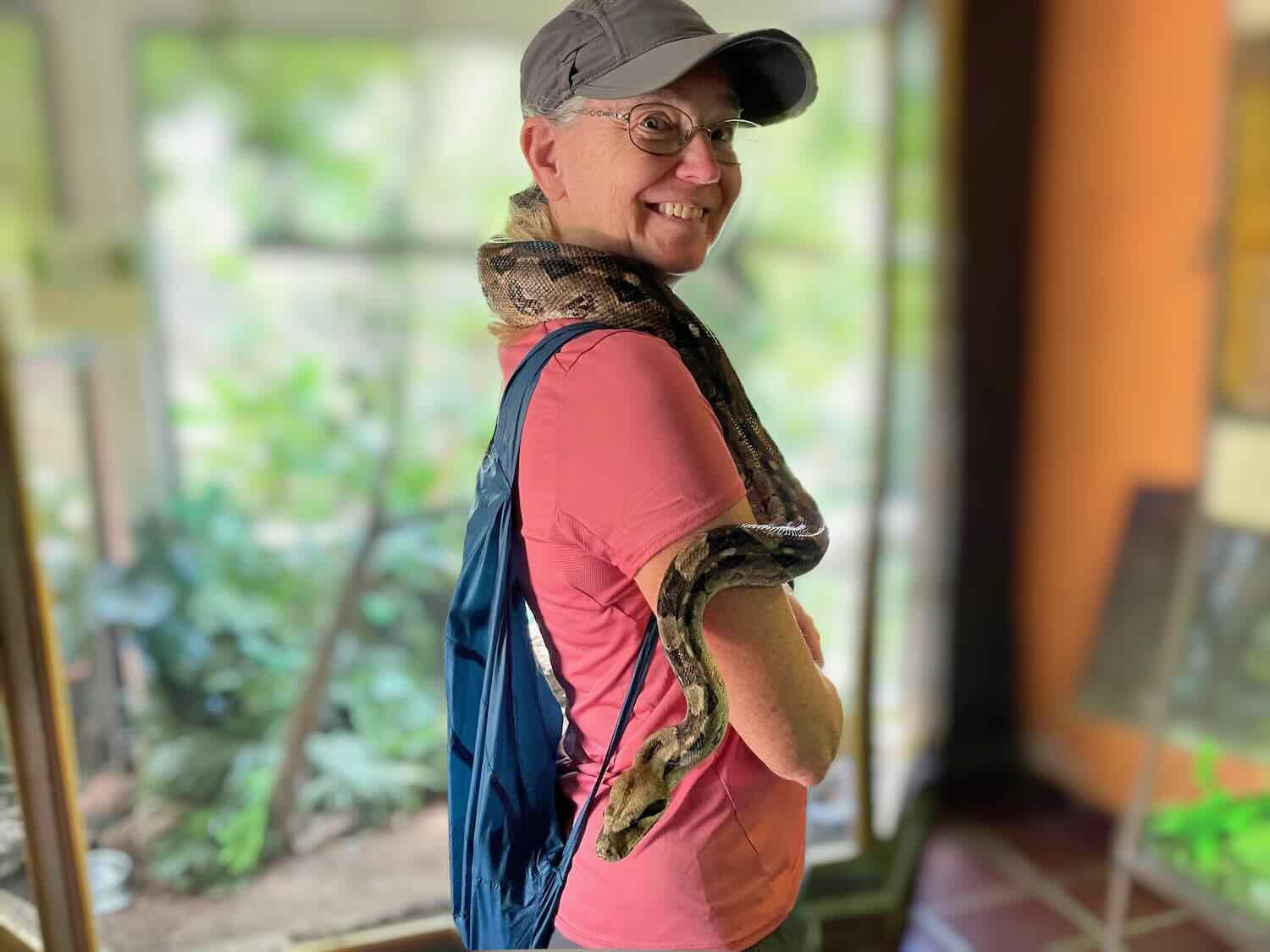

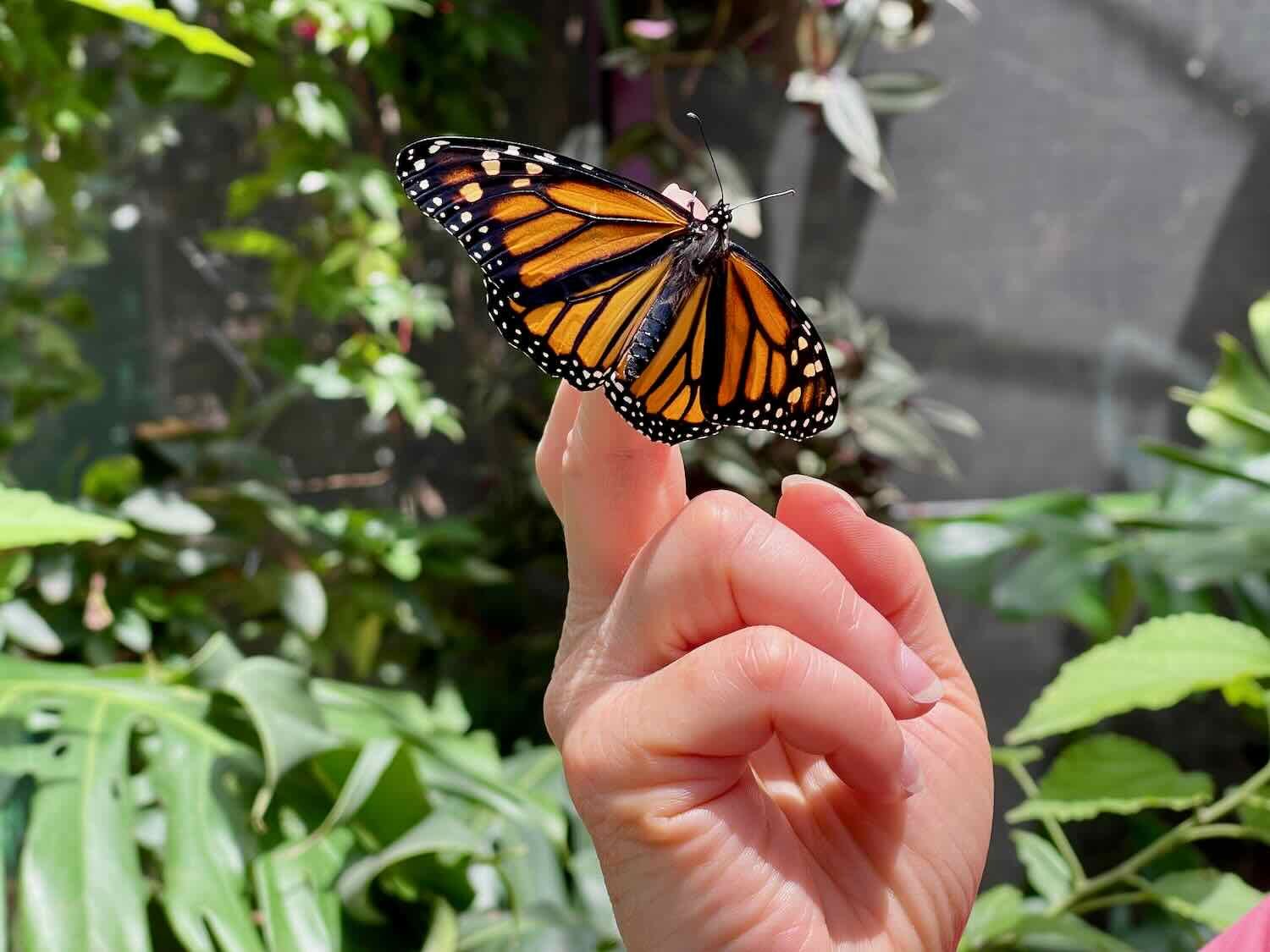
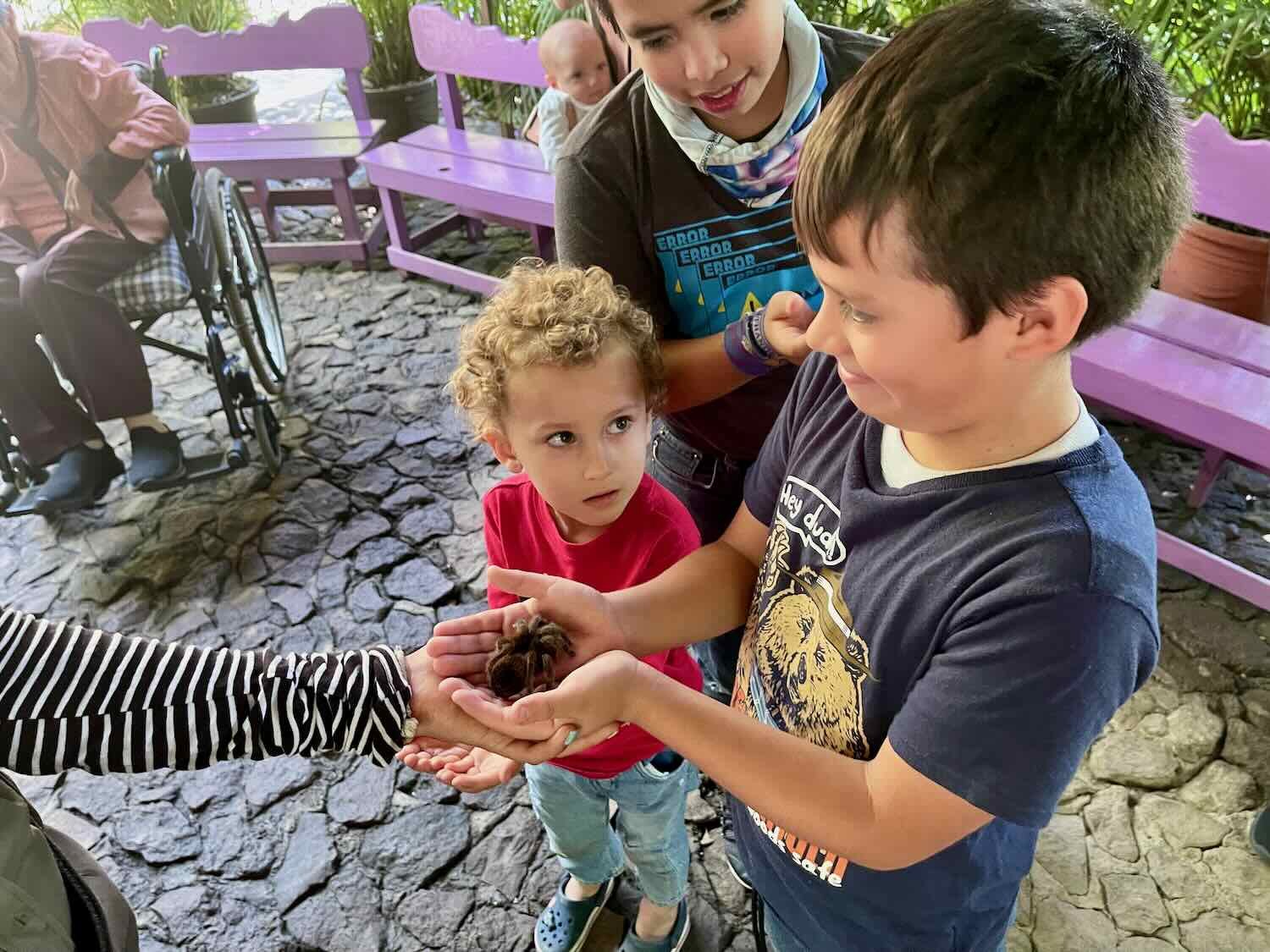
A Journey Underground
After the rest day our legs felt a lot stronger. It helped that the start of the ride was largely downhill. We covered the first 11 miles (17.5 km) by 8:30am, which was great because it was shaping up to be a hot, sunny morning.
We did have one hiccup. About 25 minutes into our ride, near the village of Puente Caporal (pop. 600), our route inexplicably turned off of the main road for a half-mile detour. We didn’t think anything of it at first, since the initial section was a fairly typical, dirt, village road. But then we hit a dead end. A quick look at the GPS route indicated that we had missed a turn. That seemed odd, since neither of us had noticed any side roads. We backtracked to the alleged crossroads to have a look.
What we found did not appear to be an actual road, at all. It might have been a footpath, but it mostly resembled a rocky creek bed. However, the only thing worse than being lost and pushing a bike down a creek bed is backtracking. Backtracking is always a last resort. Backtracking is retreat. Moving forward into the unknown is an adventure. The creek bed was slow going, with plenty of loose stones and weeds growing over the trail, but we finally reconnected with a real road.
Scrambling down the hillside on a washed-out section of trail. Puente Caporal, State of Mexico, Mexico. Copyright © 2019-2023 Pedals and Puffins.
Even more fun, when we reached the bottom of the hill we had to lift our bikes up and over a concrete retaining wall that was probably installed to keep water from our creek from washing up onto the road.
Lifting our bikes over the concrete retaining wall, to get back on Hwy 185 after scrambling down a rocky stream bed. Puente Caporal, State of Mexico, Mexico. Copyright © 2019-2023 Pedals and Puffins.
The big downhill at the beginning of the day dropped us out of the Trans-Mexico Volcanic Belt for the last time. Over the past couple of days we had descended nearly 4,000 ft (1,220 m), entering a region known as the Balsas Dry Forest, which forms the foothills and valleys running west-to-east along the southern edge of the volcanic belt. For the next 200 miles we would traverse a landscape characterized by steep-sloped, lower-elevation mountains cloaked with thick forests of broad-leaved trees, punctuated by the occasional cactus. And although the region is considered very arid - with a severe, eight month dry season - we would be seeing the forest in all its glory because of the daily, summer rains that were now upon us.
The dirt riding on the way to the Grutas de Cacahuamilpa was quite a bit easier than the day before - mostly because the conditions weren’t quite as soggy. Small plots of corn, agave and sugar cane were sprinkled among the lush trees of the forest. Whenever we could get a view through the trees, beautifully scenic valleys spread out below.
Cycling a rural road through the Balsas Dry Forest, which wasn’t so dry in the rainy season. El Platanar, State of Mexico, Mexico. Copyright © 2019-2023 Pedals and Puffins.
A peek across a scenic, mountain valley. Colonia Juárez, State of Mexico. Mexico. Copyright © 2019-2023 Pedals and Puffins.
We passed the handsome Church of St. Andrew the Apostle, constructed entirely of brick (including the bell tower). San Andrés Nicolás Bravo, State of Mexico, Mexico. Copyright © 2019-2023 Pedals and Puffins.
When we arrived at the Grutas de Cacahuamilpa National Park, the area near the parking lot was crowded with vendors and food stalls. A woman who ran one of the restaurants came over to see if we would like a meal. When we told her we first wanted to find the camping area, she very helpfully showed us where to go.
For a fee of 100p/person, travelers can camp in a secure courtyard with a pool, behind a big building where the park’s security guards live. The community bathrooms are shared with other campers, as well as the security guards who live there. The grass in the courtyard was soft and green, making for a nice, comfy bed. Plus, the camping area was right near the edge of a cliff overlooking a deep, scenic gorge. We seemed to be the only people crazy enough to camp during the rainy weather, so we had the courtyard to ourselves.
View into the Chontalcoatlán Gorge from our campsite. We could see the entrance to a mysterious cave on the far side. Grutas de Cacahuamilpa National Park, State of Guerrero, Mexico. Copyright © 2019-2023 Pedals and Puffins.
After selecting a spot for our tent, we headed back to the main vending area and rested in the shade before taking one of the guided tours of the Grutas (caves), which run every hour.
The entrance to the main cave was across the ravine from the vending area. We opted to walk to the entrance across a bridge. But some members of our tour group chose to zipline across the gorge (for an extra fee). Once everyone made it across the chasm, we descended into the maw of the cave.
A member of our tour group ziplined across the Chontalcoatlán Gorge to reach the mouth of the cave. Grutas de Cacahuamilpa National Park, State of Guerrero, Mexico. Copyright © 2019-2023 Pedals and Puffins.
The entrance of the cave looked like a huge mouth with big molars lining the walkway - ready to chew us up and swallow us after we entered. Grutas de Cacahuamilpa National Park, State of Guerrero, Mexico. Copyright © 2019-2023 Pedals and Puffins.
The caves at Cacahuamilpa are some of the largest in the world. The tour covers several miles of underground trails that pass through a series of 20 “salons” which are enormous, cavernous spaces separated by more narrow passageways. All of the salons are quite a bit larger than most underground caves. The roof of the biggest salon rises an impressive 265 ft overhead - nearly as tall as the Statue of Liberty. Within these grand spaces, huge stalactites and stalagmites dwarf the mere mortals that wander past them on the concrete pathway.
A giant stalagmite formation called “the champagne bottle” rises from the floor of one of the larger salons in the Grutas de Cacahuamilpa. State of Guerrero, Mexico. Copyright © 2019-2023 Pedals and Puffins.
Most of the formations that the guide pointed out within the cave were rock shapes that had been given poetic or humorous names, based on objects, people or animals that they resembled. But there were some solemn sights as well. There were several gravesites within the cave where early explorers lost their lives. Grutas de Cacahuamilpa National Park, State of Guerrero, Mexico. Copyright © 2019-2023 Pedals and Puffins.
The guided tour ends deep within the cave, and you can wander back out along the concrete path at your own pace. Unfortunately, we had taken one of the last tours of the day. As a result, we had to make our way back to the entrance relatively quickly in order to snag some dinner at one of the restaurants, before they closed. We enjoyed the walk back, but we didn’t linger.
At the end of the evening, we just made it into our tent before the nightly rain began to fall. By 8:30pm the rain was coming down in buckets, with loud, unsettlingly close lightning and thunder that lasted for hours. It was very dramatic. The upside was that the rain cooled things off, because it had been hot and humid all afternoon. Pretty soon the temperature was much more comfortable for sleeping. Unfortunately, two hours of very heavy rain was a bit too much for our tent. For the last hour or so we had to deal with steady dripping from all four corner seams. By midnight much of our gear and clothing was damp, and it remained that way until morning.
Some New Members of the Pack
We awoke to a misty morning.
Our misty campsite near the swimming pool. Just beyond the low wall encircling the courtyard, the land falls away into a steep, foggy ravine. Grutas de Cacahuamilpa National Park, State of Guerrero, Mexico. Copyright © 2019-2023 Pedals and Puffins.
The previous day, a couple of the local dogs had decided to join our team. They spent the night in close proximity to our tent, and barked a few times during the night while on guard duty. They even tried to escape the rain under the fly of our tent but we chased them off since we were concerned they might accidentally damage the tent. Ultimately they took shelter under a nearby bush.
Nearly all of the stray dogs in Mexico are constantly on the lookout for a human that will take them in. Some of the dogs are free roaming, but are cared for to some degree by various people in the neighborhood. Many of them have very sweet personalities, and can melt your heart with their efforts to be loved.
We had previously heard about dogs that followed other cyclists for many miles in hopes of being adopted - potentially putting themselves in danger along the road, or being vulnerable to other dogs after leaving their home territory. Once a dog leaves an area where it knows how to obtain food, it becomes dependent on the people it followed. This can put cyclists in a real bind, who don’t want to abandon the dogs but at the same time can’t really take care of them. So as a general rule, we avoided getting friendly with any stray dogs, because we really didn’t want to encourage them to think we might be a good prospect for a long-term relationship. The dogs are best left in an area that they are familiar with, and where they know how to find food and water.
As we packed up our things, we both noticed that the two dogs who spent the night near our tent seemed to have formed an attachment to us. We tried chasing them away a couple of times, but they always came right back.
A pair of sweet-tempered, stray dogs looking for a new home. Copyright © 2019-2023 Pedals and Puffins.
When we cycled away from the caves, we were distressed to see that the two dogs followed us - and we even picked up another one on the way through the parking lot.
We rode on a sidewalk for the first quarter mile to a nearby town, with the dogs trotting along behind us. We hoped that they would turn back once we rode out onto the highway after reaching the town. But they didn’t. On the blacktop, we tried to outpace them. But the first 1.5 miles had a pretty significant uphill gradient, so the dogs easily kept up with us. We began to get very concerned that they would follow us far enough that it would be hard for them to find their way home.
We got aggressive, trying to chase them away several times brandishing sticks and throwing stones (close enough to scare, but not hurt them). And although they would back off a little, they would soon be back on our tail, following us as we cycled away. They were fast dogs. A couple times we went down hills at 15-20 mph, but they would easily catch up to us on the next uphill.
Finally, 2.5 miles into the ride, at the top of a really big, long hill, we decided to split up. PedalingGal went ahead down the hill while PedalingGuy chased the dogs back toward home. At first it looked like this strategy wasn’t going to work, when the dogs took off after PedalingGal down the hill. But PedalingGuy was able to call them back, and drive them off back towards the park where we had spent the night. Then he quickly raced down the hill as fast as possible. And that was it. We had finally lost them. It was a straight shot for them to get back to their home, and there was hardly any traffic on the road. So we hoped they would make it back okay. It was a huge relief for us, but it still took a bit of time to shake the sense of guilt. It’s really tough to see the dogs so desperate to find a permanent home, with their own human to care for them.
Finally, we were able to tackle the many hills along the route at a more leisurely pace. We had worn ourselves down trying to ride as quickly as possible in hopes of outpacing the dogs. Now, we could take the time to stop and enjoy the scenery. We spotted a couple of interesting birds along the side of the road. Particularly noteworthy was a handsome, black-chested sparrow - a species restricted to the foothills and high mountain valleys of south-central Mexico. We also saw a family of groove-billed anis with at least three fledgelings that looked like they had just recently left their nest.
The route meandered through a long valley bordered with rugged, forested mountains. There were endless, gorgeous views of verdant, green hills. The valleys were blanketed with farms and fields. Casino de la Unión, State of Guerrero, Mexico. Copyright © 2019-2023 Pedals and Puffins.
Approaching the town of Teacalco we came across a curious sight - a large airplane was parked on a hilltop not far from the road. It turned out to be the jet that had been used by a famous Mexican singer while traveling on tour. And it was parked on one of his former ranches that has been turned into a tourist attraction. In addition to the airplane there are landscaped gardens, a restaurant and horse shows. It’s quite a big project for such a rural area.
The airplane used by a famous, Mexican singer sits incongruously on a hilltop in rural Mexico. How they got the plane into the mountains is hard to say, but it reminded us of something from the movies. Rancho La Octava Maravilla Joan Sebastián, State of Guerrero, Mexico. Copyright © 2019-2023 Pedals and Puffins.
As the day grew hotter, we stopped to rest often. At one point we took a break at a taxi stop that had a bench and an awning that provided some welcome shade. While we were there, a taxi driver stopped to eat his lunch and chat with us. Philip had spent three years in Chicago, but he preferred to speak with us in Spanish. He was incredibly nice, asking about our trip and commending us for traveling in a healthy way instead of using a car. He seemed very pleased that we had stopped in his town (Puente de Ixtla). The town had a few hills that were extremely steep - so steep we weren’t even sure we could push our bikes up them. We finally did some rerouting, and eventually got back on track while avoiding the worst hills.
We pushed through the last 40 minutes of cycling into Tehuixtla (pop. 6,500), laboring over a couple of more hills on quiet, but paved back roads. We were happy to finally arrive at our destination, where we checked into a peaceful hotel run by a very kind gentleman named Napoleon.
Arrival in the town of Tehuixtla, “Land of God.” Tehuixtla, State of Morelos, Mexico. Copyright © 2019-2023 Pedals and Puffins.
A colorful display of “ojos de dios” (god’s eye) ornaments brightened up the main street in town. Tehuixtla, State of Morelos, Mexico. Copyright © 2019-2023 Pedals and Puffins.
A Change of Plans
We had been planning to cycle the remainder of the TransMexico Norte route all the way to Oaxaca. But a combination of factors including concerns about a land dispute between a couple of the rural towns along the way, the still-very-hot weather, the probability of having to deal with muddy conditions on dirt backroads during the rainy season, and at least one, gigantic, single-day climb of 7,000+ ft (2,150 m) had us second-guessing ourselves. After talking it over, we decided to take an all-pavement route from Tehuixtla to Oaxaca. Consequently, we took a day off in Tehuixtla to plan our our new strategy. All the pieces fell into place just before bedtime.
Some Quick Miles on an Autopista (Toll Road)
The road out of Tehuixtla led us north, past lots of small farms before reaching the southern end of a large lake. There, a missed turn caused us to add about 2.5 miles (4 km) to our ride. Luckily, we hadn’t planned for a very long day.
Back on track, we cycled through the bustling small city of Jojutla de Juárez (pop. 57,700). There were tons of retail stores lining the road, giving us a feel for a very different type of town than the ones typically encountered along the Baja Divide and TransMexico routes.
We were mesmerized by the abundance of former road signs decorating the top of a restaurant. Jojutla de Juárez, State of Morelos, Mexico. Copyright © 2019-2023 Pedals and Puffins.
The dairy cow in that truck looked like she wasn’t sure this was such a great idea. Outskirts of Jojutla de Juárez, State of Morelos, Mexico. Copyright © 2019-2023 Pedals and Puffins.
From there we rode onto one of Mexico’s modern, high-speed toll roads - known as an autopista. Officially, bicycles are not supposed to ride on these roads. But except for a few toll roads near the northern border with the USA, the highway officers generally don’t seem to mind a few cyclists passing through. In fact, it’s fairly common for Mexican cyclists to ride on the autopistas. Although we were slightly apprehensive about getting turned away, everything worked out fine. The officials at the only toll booth that we passed smiled and waved us through.
Riding on the autopista was a breeze. The road surface was silky smooth, there was a wide, safe margin, and there wasn’t very much traffic. We moved along at a brisk pace, even though the overall elevation profile was uphill. For the next two hours there weren’t any towns to speak of. Instead, we cycled past big fields of corn, sugar cane, and something else that was newly planted (maybe beans). .
Cycling on the wonderfully wide margin of Autopista 94D. State of Morelos, Mexico. Copyright © 2019-2023 Pedals and Puffins.
We passed through one, fairly short tunnel on the autopista. Even in the tunnel the road had an amazingly wide shoulder. Autopista 94D, State of Morelos, Mexico. Copyright © 2019-2023 Pedals and Puffins.
It was very sunny. As the morning progressed, it grew oppressively hot. Without any other shade, we stopped in the shadow of several highway overpasses for some relief. A soft, cool breeze helped keep us from overheating.
To our surprise, there were large numbers of butterflies along the side of the road - including at least five different species. They seemed to be attracted to a mineral in the mud that lined the highway. As the day grew warmer, the number of butterflies increased until we were cycling through clouds of fluttering wings. We hadn’t experienced anything like that since we rode on the Stewart-Cassiar Highway, way up in British Columbia, Canada. It was fun.
Among the butterflies we saw along the side of the road were large numbers of elf butterflies and elada checkerspots. Autopista 94D, State of Morelos, Mexico. Copyright © 2019-2023 Pedals and Puffins.
A bit further along the highway there was a large gathering of black vultures. We couldn’t see what had attracted them. But it was likely a dumping ground for carcasses from a nearby farm. Autopista 94D, near San Rafael Zaragoza, State of Morelos, Mexico. Copyright © 2019-2023 Pedals and Puffins.
When we arrived in the small town of San Rafael Zaragoza we headed straight for the hotel where we had planned to spend the night. But we couldn’t find it. On the street where our map said the hotel should be, at the outskirts of town, all we we found was a row of rundown houses.
Not yet ready to give up, we asked a woman on the street if there was a hotel in the area. She pointed us back in the direction where we had already failed to locate the hotel. But at least she gave us some additional information. She told us that it had a white door, and gave us an idea of how far down the road it was. So we went back for a second look.
What we found was a very rundown building that looked like it hadn’t been in business for a while. We peered through the gate, and saw a garden totally overgrown with plants. It looked abandoned - and it was not really the kind of place we would feel comfortable staying even if someone did miraculously appear to let us in.
Wondering what to do next, we cycled a couple of blocks to the center of town and asked the cashier in a small tienda if there were any hotels. The first one she mentioned was the one we had just left, so we told her it seemed like that one wasn’t in business anymore. After a bit more thought she suggested that we go back onto the autopista where there was an OXXO convenience store that had a few rooms for rent upstairs. She didn’t know of any other hotels in the area.
Our online map, however, showed a hotel in the next town down the road. And it looked a lot more appealing than spending the night in a motel room over a convenience store on the toll road. Luckily we had a cell phone signal. So we gave the other hotel a call, and to our delight, they did exist. They even had a room for us. We told them we were on our way.
A couple of steep hills later we arrived at the point on the map where the hotel was supposed to be. But once again, we couldn’t find it. There was no sign out front marking the building as a hotel. We got out our phone again to look at some of the photos online, and that helped us locate the correct building. It was a good thing we had access to those photos, because the “hotel” looked like just a regular house in a neighborhood, with a couple rooms that they had set aside to rent. They also had a locked gate for security.
It turned out to be a very nice hotel for a surprisingly modest price. The mother and daughter team that welcomed us were very sweet, and were glad to have us as guests. There was no air conditioning, but the room had decent wifi and was squeaky clean. One of the walls of the room was completely covered with huge windows, so it seemed like a good bet that we would be able to cool off the room in the evening.
Finding dinner in the town of Chinameca (pop. 3,150) turned out to be a bit more difficult. We ended up walking all the way back to the main highway - a distance of nearly a mile - without finding anything to eat. When we had rode through that area on the way into town, there had been a bustling market in full swing. But by the time we went looking for dinner, all of the stalls were closed. Lunch is the big meal in Mexico, so finding a place for dinner in a small town can be a challenge when all the roadside taco and food stands are closed.
Along the way we passed through the town square and stopped to admire a big, bronze statue of Emiliano Zapata - a hero of the Mexican Revolution, particularly in southern Mexico. An older gentleman who had been sitting near the statue came over to talk to us, and was eager to tell us about the town’s history and connection to Zapata. Unfortunately, we had a really hard time understanding much of what he said because he had an unusual accent, and used a lot of slang we were not familiar with. Luckily, he pointed us to several signs posted around the plaza that described how Zapata was assassinated near the town’s central plaza in 1919, after being betrayed by another general that he thought was his ally. It was a huge moment in Mexican history. And it took place right in the center of this small, now sleepy town.
Statue of Emiliano Zapata, a hero of the peasant class in the Mexican Revolution. He was assassinated near the town square in the early 1900s. Chinameca, State of Morelos, Mexico. Copyright © 2019-2023 Pedals and Puffins.
Then it was back to the hunt for dinner. Near the central plaza, we went into a tiny shop that only sold chips and drinks. We asked the shop owner where we could get food. He took us outside and asked a woman who lived nearby if she could help us. She said she could cook for us, and took us into her house where she prepared a few quesadillas with chicken. Combined with some chips and drinks from the store, it made a nice, filling dinner.
Into the Land of the Tecuán (Jaguar)
We slept with all the windows open. That helped us to be cool enough, but it also let in a lot of noise. Throughout the night we were serenaded by chickens, donkeys, cows (yes, cows), barking dogs, shrieking cats, and a few motorbikes here and there. It was not a particularly restful night.
Back out on the road, we cycled up a gentle ascent for most of the day. We passed through a number of very small towns surrounded by fields of sugar cane, corn, and some freshly-planted seedlings. For the first time in quite a while, we also cycled through some citrus orchards.
Perhaps the most interesting crop was a spindly-looking cactus we saw growing under tents of protective mesh. On closer inspection, we discovered that these were dragon-fruit plants (“pitaya” in Spanish). We’d always associated dragon fruit with Asia. But it turns out that the cactus is native to Central America, and has been part of the Mesoamerican diet since ancient times.
An “orchard” of dragon fruit plants, protected from birds by a shelter of light mesh. North of Chinameca, State of Morelos, Mexico. Copyright © 2019-2023 Pedals and Puffins.
A homemade cattle-crossing sign. Near Tepalcingo, State of Morelos, Mexico. Copyright © 2019-2023 Pedals and Puffins.
Cinnamon-rumpled seedeaters were common near the farm fields, often perched on utility wires that ran along the side of the road. Tepalcingo, State of Morelos, Mexico. Copyright © 2019-2023 Pedals and Puffins.
We made great time, arriving in the bustling town of Axochiapan (pop. 19,000) around 11:30am. At the entrance to town we got our first glimpse of a Tecuán - a mythical animal based on the jaguar that looms large in the folklore of this region. In the center of a roundabout stood a statue of a spotted creature with a catlike face, swinging a whip over its head. The image invokes the fearsome beast at the heart of a traditional dance that is performed throughout the native Mixtec region, which encompasses parts of the Mexican states of Morelos, Puebla and Oaxaca.
A mythical Tecuán beast guards the entrance to the town of Axochiapan. State of Morelos, Mexico. Copyright © 2019-2023 Pedals and Puffins.
Axochiapan was a very working-class town with narrow streets and well-worn buildings. When we reached our target hotel, it was definitely underwhelming. We had expected that it might be a bit run down, but seeing it in person drove the point home.
After taking a few minutes to consider our options, we decided to try our luck down the road. There possibly was another hotel about a mile and a half away, but we couldn’t be sure. They did not answer their phone when we tried to call. Plus, it was outside of town so there wouldn’t be a lot of dining options nearby. However, since it was still really early in the day, and we were not too tired, we decided to give it a try. If things didn’t work out, we still would have time to find another alternative.
Within 15 minutes we arrived at the tranquil Hotel Finca San José, and we were really glad we had passed on the previous hotel. This one had a large, well-tended garden dotted with palm trees, an historic-looking brick building, and big wooden doors sporting old-fashioned, wrought-iron locks that used skeleton keys. Best of all, it had both air conditioning and a mini refrigerator to keep drinks cold. Refrigerators in hotel rooms have been a rare treat in Mexico. It was wonderful - one of the best rooms we’d had in a long time. We couldn’t have asked for more.
The rooms at the Hotel Finca San José had heavy, blue, wooden doors with big, wrought iron locks that looked like they had been crafted by a blacksmith in the early 1700s. Axochiapan, State of Morelos, Mexico. Copyright © 2019-2023 Pedals and Puffins.
We enjoyed the comforts of the room so much that before bed we decided we would stay for another day. But the Universe had other plans. Not long after we went to bed a huge storm rolled in, with massive amounts of lightning and thunder. Well before midnight the power cut in and out several times, and then it went dead. There went our air conditioning.
The power remained off throughout the night and next morning. We woke up around 6am, and decided we didn’t really want to stay an extra day in a room without air, power, a functioning refrigerator, wifi, or even water (the water pumps ran on electricity). As if to underscore the point, there was also a fairly deep puddle of water in our bathroom that probably leaked in through a window during the rainstorm. Shifting gears again, we packed up our things and got back out on the road. The power was still out when we departed.
Barbecued Goat
It was a damp morning with lots of low clouds. Fortunately, the clouds initially kept things a bit cooler, until they burned off around 10:30am. We especially appreciated that because most of the day we were headed uphill. In a familiar pattern, we continued cycling through farm fields and small towns with picturesque plazas and churches. The surrounding mountains and lush vegetation were pleasing to the eye, but the scenery wasn’t particularly impressive.
The central church in one small town was painted in an unusual color scheme of pink and pale blue. Atencingo, State of Puebla, Mexico. Copyright © 2019-2023 Pedals and Puffins.
A video of an eye-catching display on the road to Izúcar de Matamoros. State of Puebla, Mexico. Copyright © 2019-2023 Pedals and Puffins.
We made great time, approaching the final mile well before noon. If we arrived too early, we probably wouldn’t be able to check into our hotel. And we didn’t relish the idea of just hanging around, waiting for the room to be ready.
So when we passed a roadside barbecue place that was packed with people, we decided to stop for a break and check it out. Pretty quickly we realized that all they served was barbecued goat meat. But we figured that with all those people crowding the tables, it must be good.
We parked our bikes and settled into a couple of chairs. Unfortunately, the waitress spoke incredibly fast and it was hard for us to understand what she said. Even though the restaurant seemed to have only a couple of items on the menu, she rattled off a long list of options. Not sure what we were getting into, we asked her to bring us whatever was most popular. Then we waited to see what food would appear.
It was not quite what we expected. We had each ordered a couple of tacos because, in our experience, tacos tend to be fairly small in Mexico. But these were really big. They were rolled in several tortillas, and stuffed to the brim with barbecued goat meat. The other item we ordered turned out to be a soup with goat meat, chickpeas, rice and carrots. Everything was well seasoned and absolutely delicious. The whole experience was delightful (although we had ordered a bit too much food, and were totally stuffed by the time we were done).
Delicious tacos de chivo (goat’s meat tacos) for lunch. Approaching Izúcar de Matamoros, State of Puebla, Mexico. Copyright © 2019-2023 Pedals and Puffins.
Then we cycled the final mile up into town. The Hotel Matamoros was a bit run down, but it did have air conditioning and plenty of space for us and our bikes. That was all that really mattered to us, as the midday temperature soared past 90F (32C).
We enjoyed a lovely dinner near the main plaza, with a view of the bright yellow church and cheerfully painted municipal building. As we left the restaurant, a big, dark cloud was approaching fast. Lightning cracked not far away. We grabbed some drinks at a small store, then raced back to our hotel. Moments after we were safe in our room the big storm arrived. We were worried that the power might go out again. But fortunately, it did not.
The colorful central church and municipal building, under a sky darkened by an approaching storm. Izúcar de Matamoros, State of Puebla, Mexico. Copyright © 2019-2023 Pedals and Puffins.
Rain Day in Matamoros
With all the unsettled weather, we decided to spend a layover day in Izúcar de Matamoros. We did manage to get out for a long morning walk before the afternoon rains arrived. With a population of nearly 83,000, it’s a bigger city than most we had been in since leaving Toluca. We enjoyed wandering through the city market and checking out some of the public plazas.
A colorful display of fruit in the city market. Now that we know they grow dragon fruit in the area, we’ve been seeing them everywhere in the markets. The dragon fruits are the bright pink ones (center, right). Izúcar de Matamoros, State of Puebla, Mexico. Copyright © 2019-2023 Pedals and Puffins.
Of particular note was a backstreet known as the Callejón de los Murales (the “alley of the murals”). There, the walls for several blocks on both sides of the street are covered with murals painted by local artists. Here are some of our favorites:
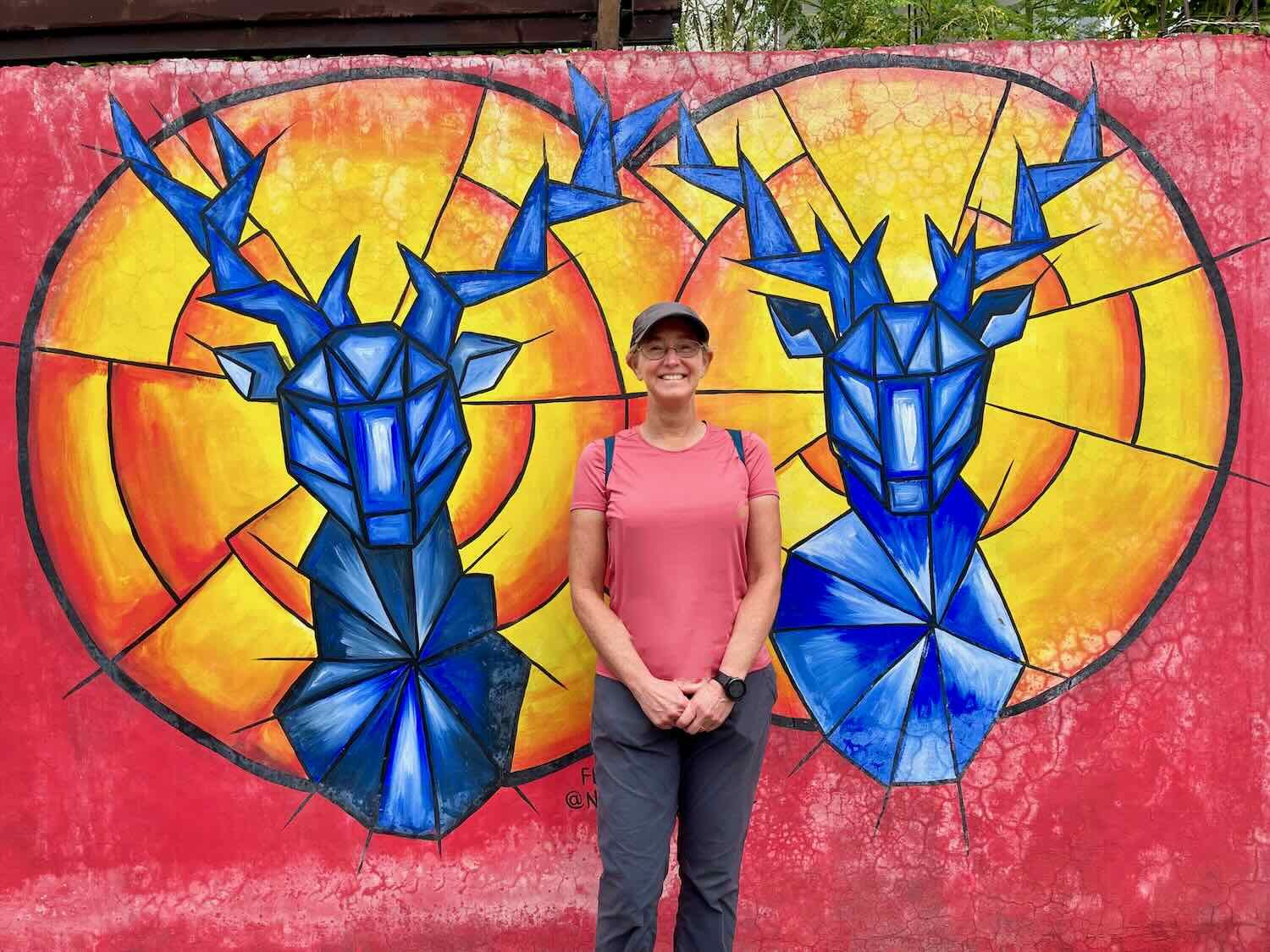
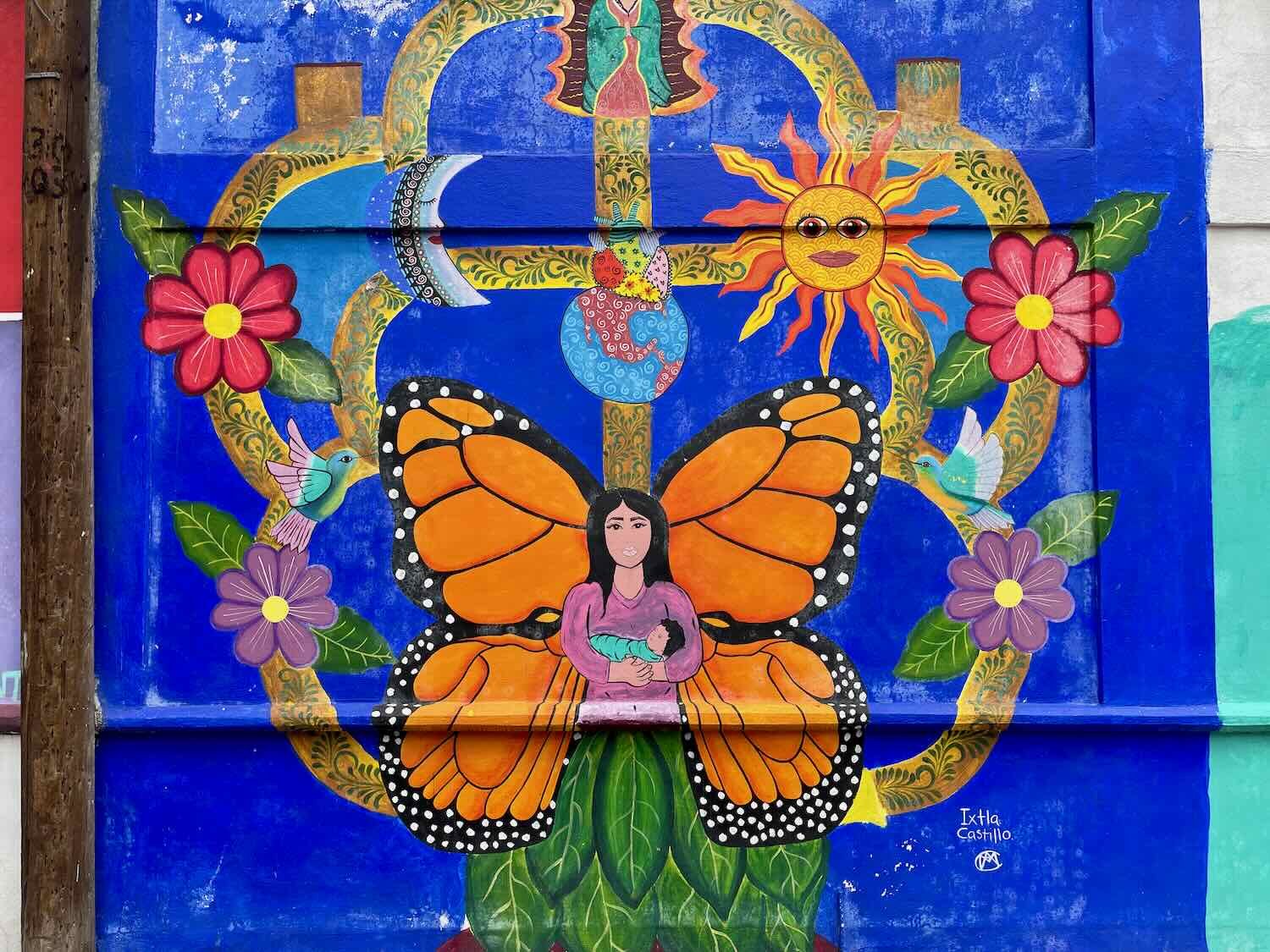
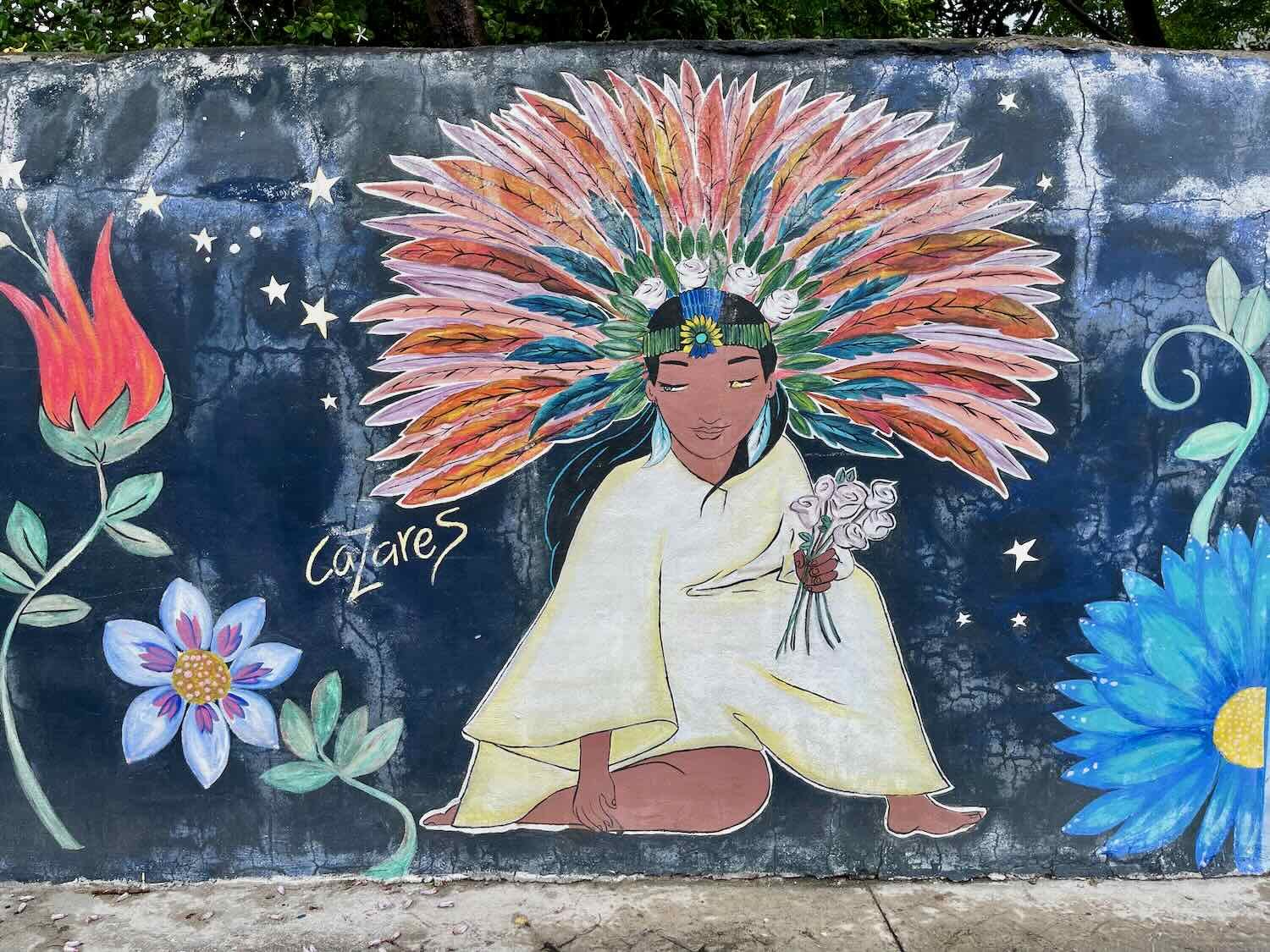
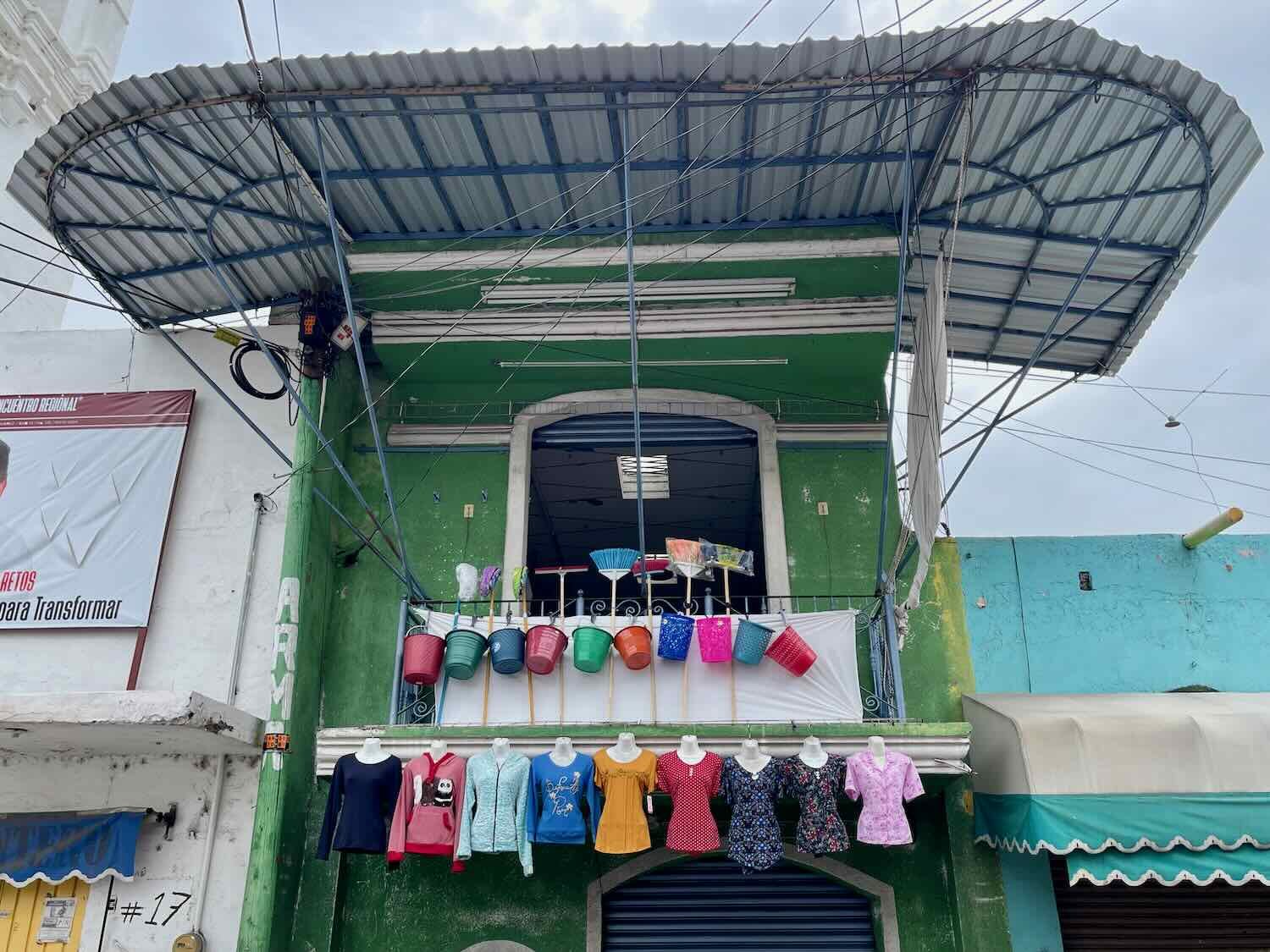
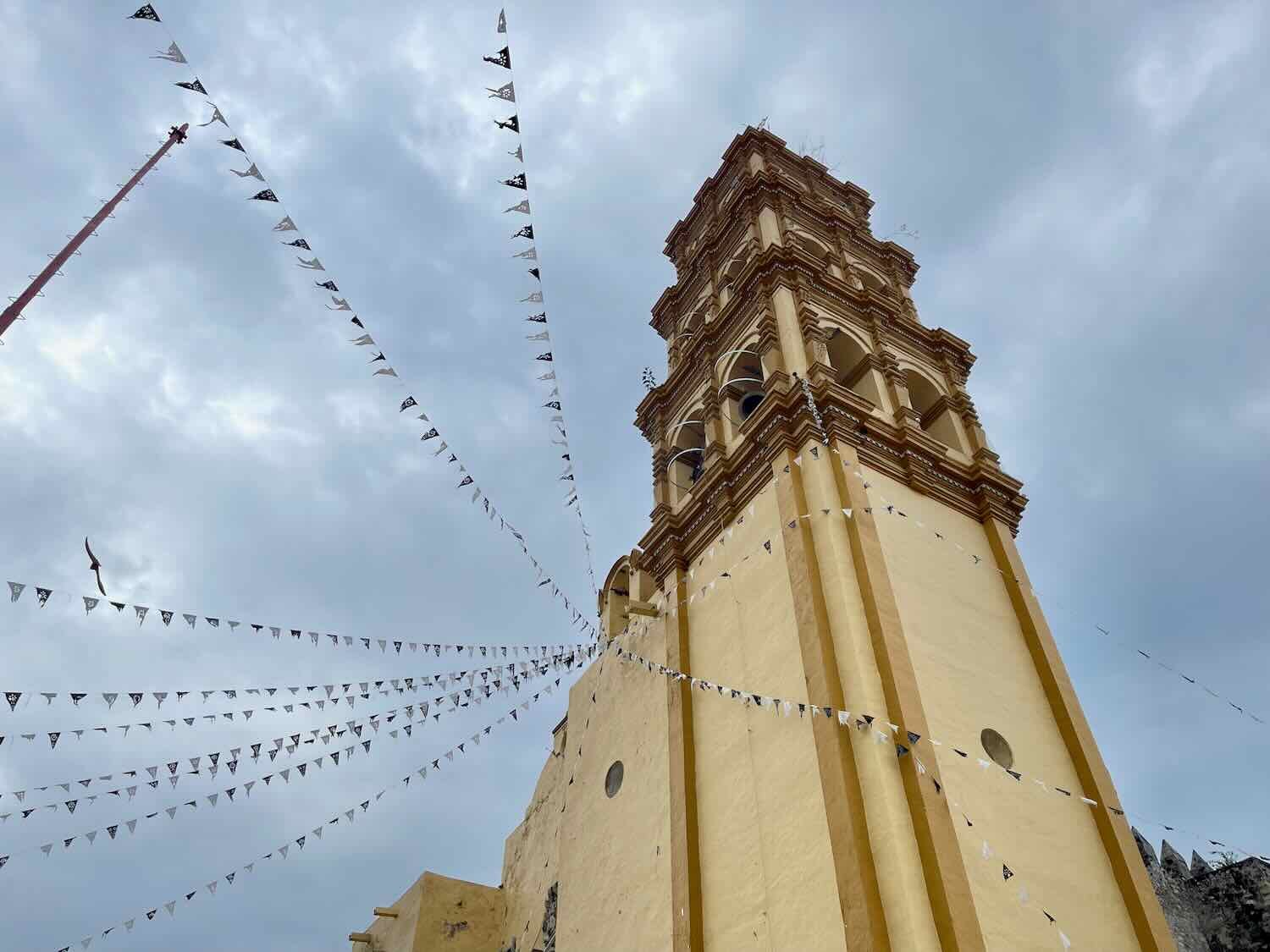
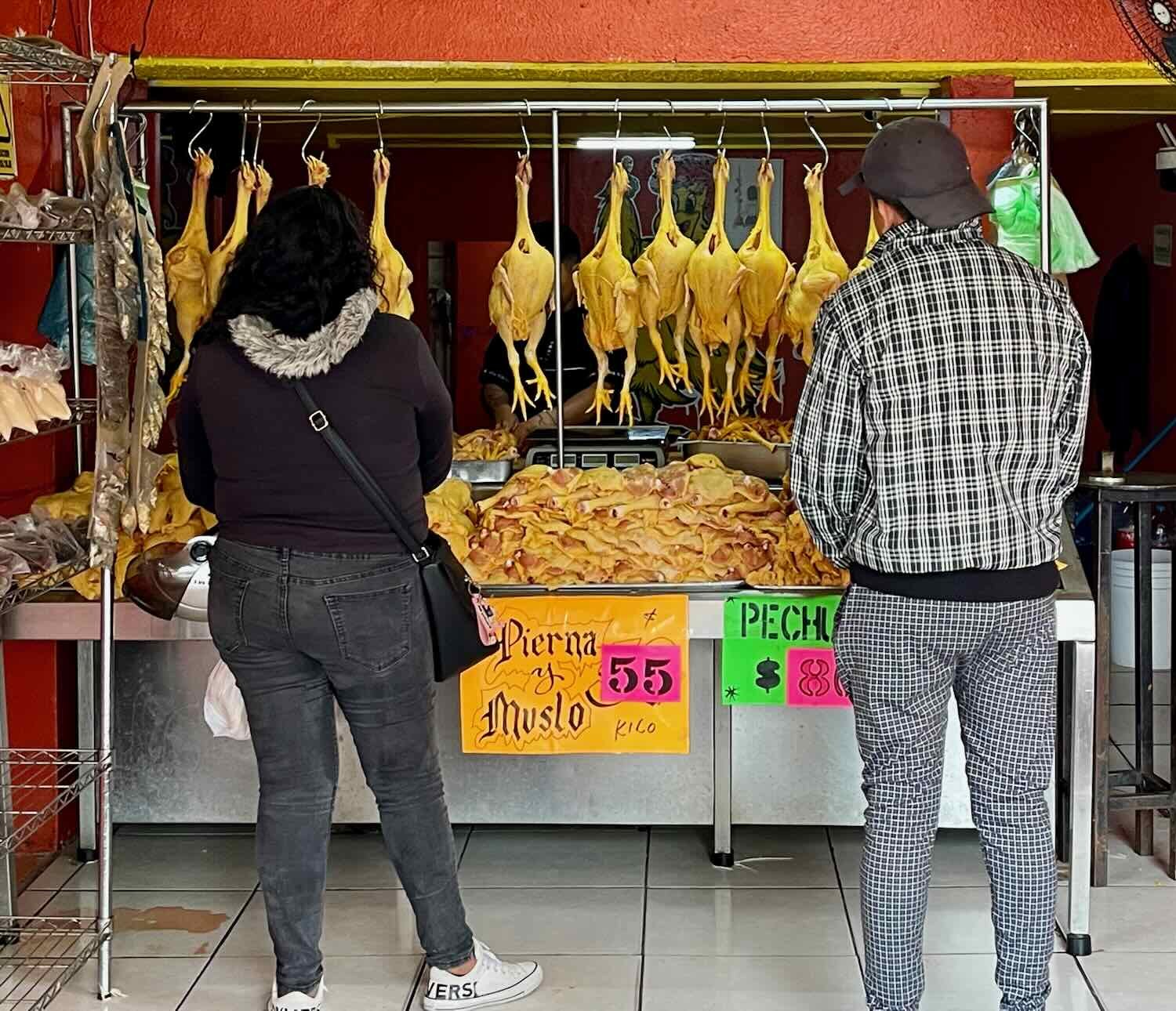
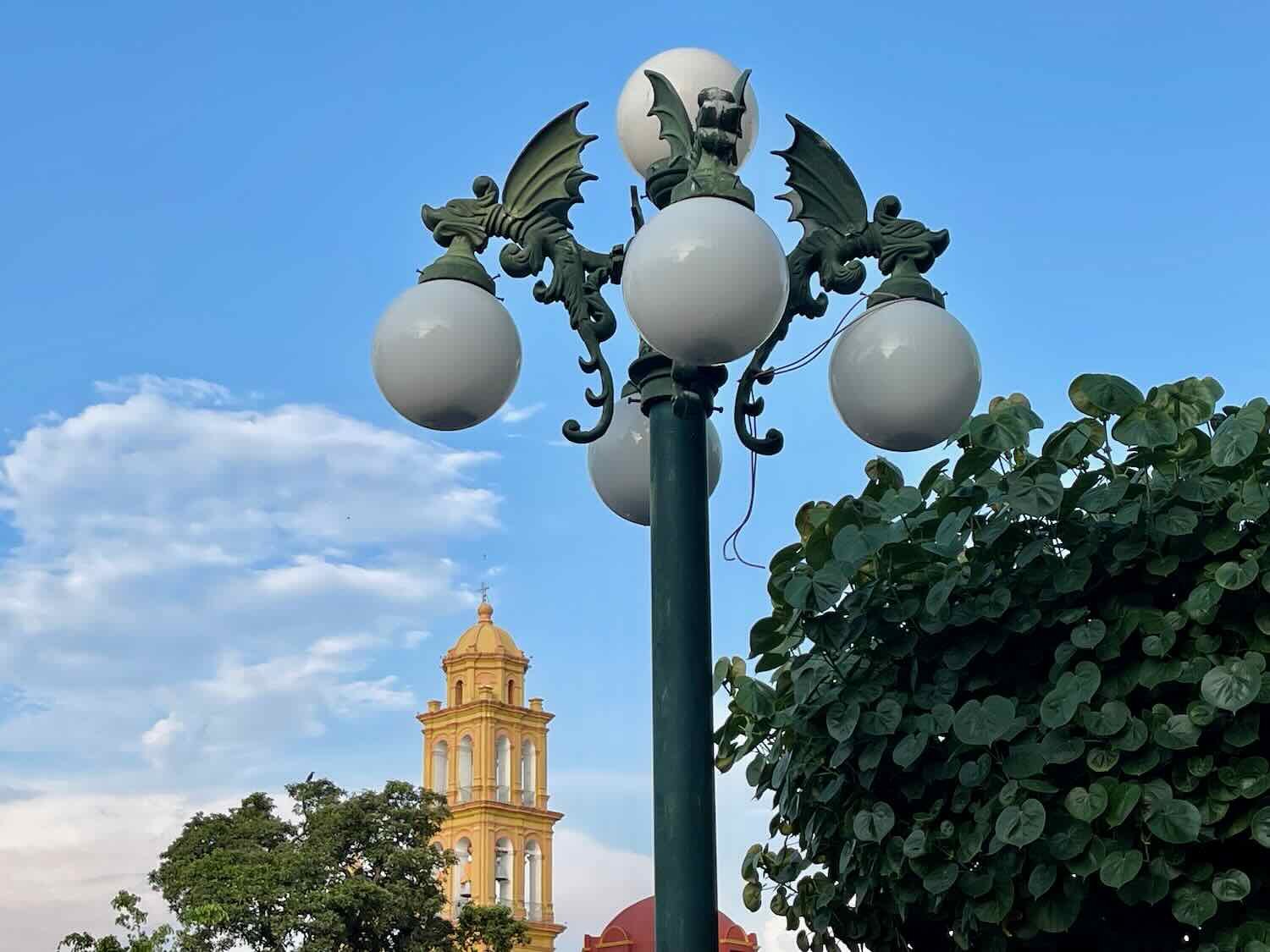
The Pleasures of Being Back on the Road
We had spent nearly two months off our bikes in a bid to avoid cycling during the wettest part of the rainy season in Central America. But the decision of a border agent to give us just 90 more days to finish our journey across Mexico meant we had to get back on the road sooner than we had originally planned - dodging tropical storms along the way. We rode short days to avoid the rains. But being back on our bicycles was wonderful because each day brought a new set of pleasures and challenges as the landscape rolled slowly by. Our legs grew stronger as we adapted to the daily routine of pedaling to our next destination. And wonderful, hidden gems like the Museum of Life in Malinalco, the cave at the Grutas de Cacahuamilpa National Park, and the gorgeous forests that lined our route brought us back to living in the moment and savoring each day, something that always seems easier on a bike trip. It’s good to be back on the road.
